When we launched the Scroop + Virgil’s Fine Goods Cassandra Stays someone asked about the different tab shapes of the Augusta Stays (pointed triangular tabs) and the Cassandra Stays (rectangular tabs).

I love a good ‘learn about historical fashion by comparing what you see in extant examples’ post (like the one I did on late 18th century sleeve stripes), and thought this was the perfect topic for that.
So, I combed museum catalogues for 18th century stays, assembled a bunch (I may have gotten carried away…) and analysed the tab shapes.
There are two main tab shapes that you see on 18th century stays: Rectangular, and Triangular.
Rectangular tabs can have 1) crisp, sharp corners, 2) gently rounded corners, and 3) very rounded corners.
Triangular tabs can be 1) full points, or 2) a very angled shape with a truncated point.
Let’s look at examples of each type, and see if there’s any correlation between tab shapes and dates, or locations.
I have arranged the stays chronologically by date (or as close as possible to) within each category.
Rectangular Tabs
Rectangular tabs with sharp corners
Starting with a non-standard piece, as these are boned bodices/smooth-covered stays worn as outerwear. The polychrome example has long rectangular tabs. Interestingly, the tabs on it and the gold court bodice appear to be finished by wrapping the fabric to the back, rather than binding the tabs. It’s not clear if the tabs are extensions of the stay body, with bones carried from one to the next, but with a join in the covering fabric, or if the tabs are completely separate pieces.
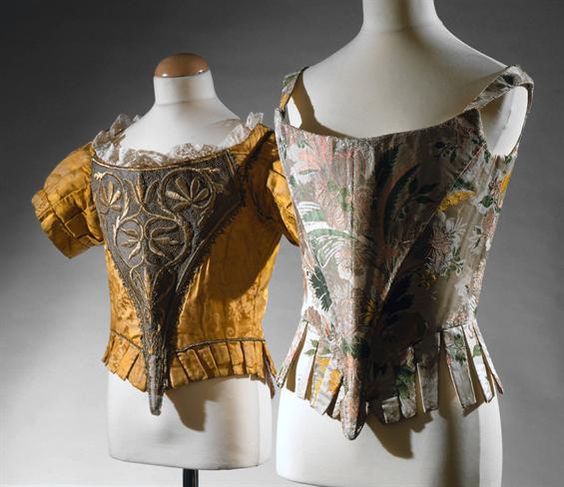
Women’s sleeveless bodice of brocaded silk (right) circa 1720. Museu Nacional do Traje. Accession Number- 29684 TC Inventory # 4192
This 1730s-40s example has some tabs that are almost truncated triangles, but most are rectangular:
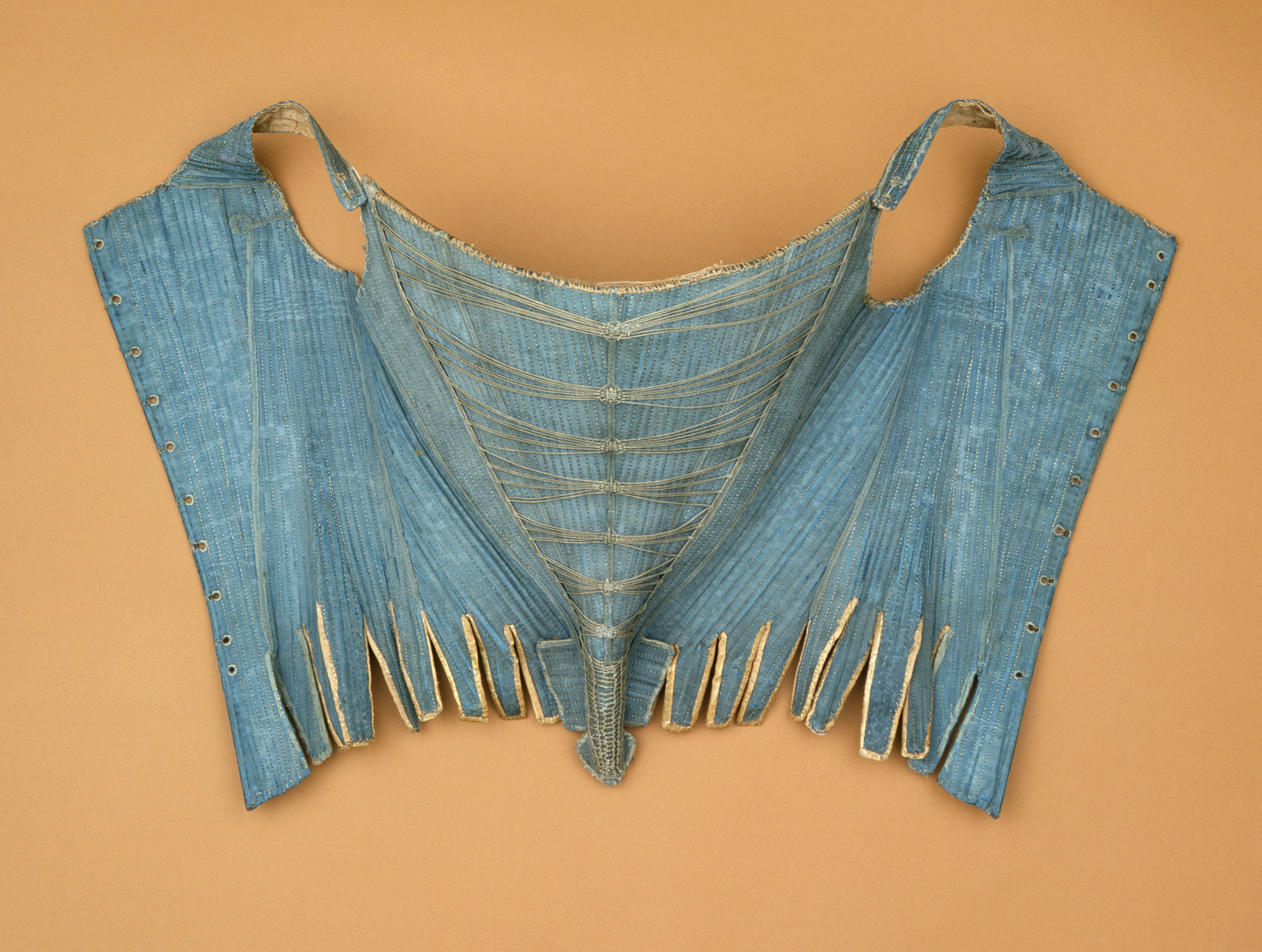
Woman’s Corset (Stays), Unknown, England, 1730s-1740s, Costumes, Silk moire, silk cording and ribbons, linen lining.
Both the shape of this pair of stays, and its tabs, are similar to the one above:
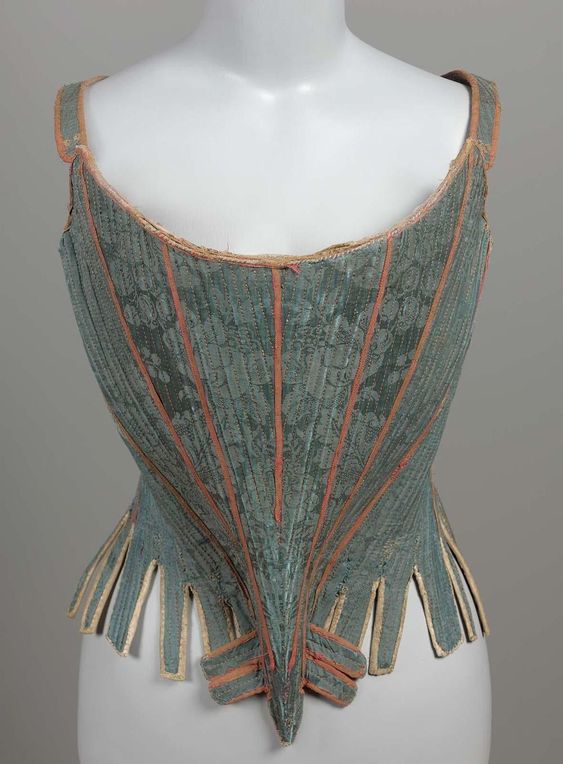
Stays. French, About 1750. Whalebone. Blue silk damask; block printed cotton lining. White kid tab binding and lining. Red silk tape over seams. MFA Boston 43.761
Although the first two tabs from the front on this pair are slightly triangular, all the other tabs are crisp rectangles, so I would place it in this category:
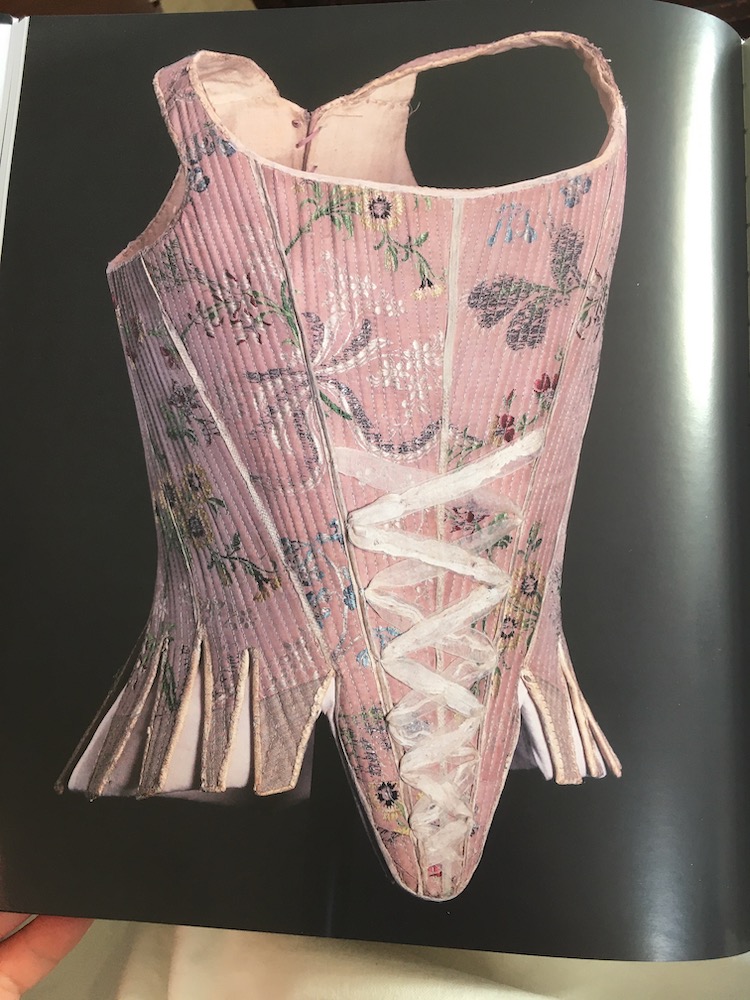
Stays of violet taffeta dated 1750-60, featured on page 110 of Stays or a Corset, Narodni Muzeum, Czechia
This pair is interesting, as some of the work on it is incredibly fine and beautiful, but tab binding is rather rough. The angle of the tabs makes it hard to see if they are true rectangles, or slightly tapered:
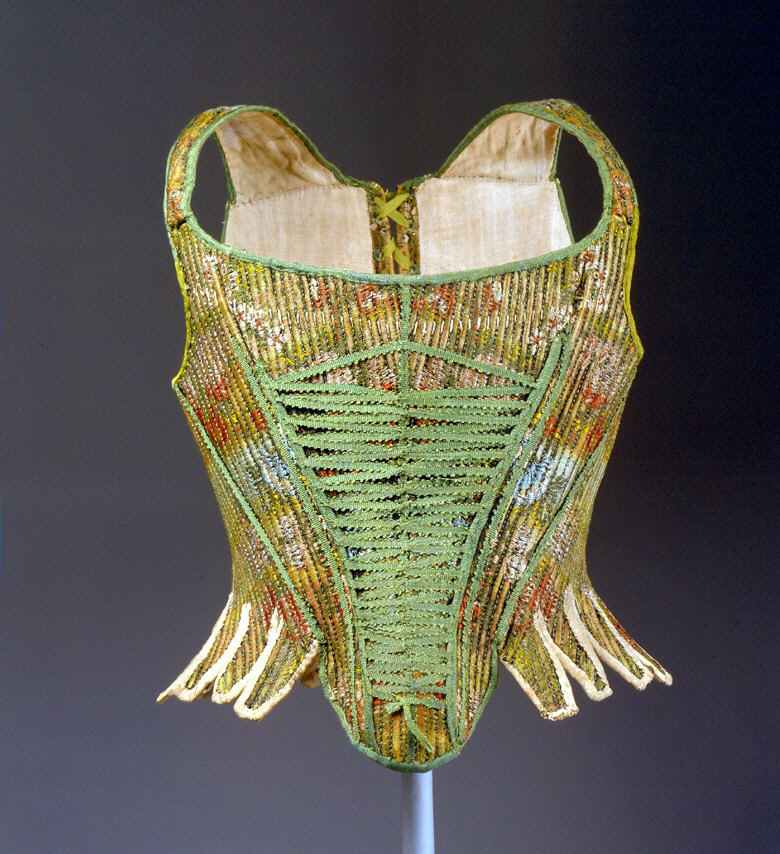
Stays, late 1760s, French, silk, linen, leather, wood, baleen Credit Line- Gift of Mrs. William Martine Weaver, 1950, Metropolitan Museum of Art, C.I.50.8.2
Very rectangular tabs:
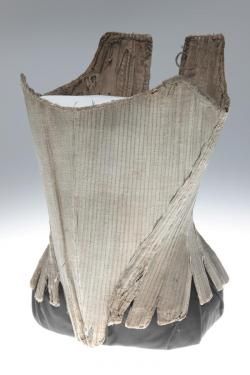
Missouri Historical Society Canvas stays (corset) stiffened with paste. (1775)
Short rectangles:
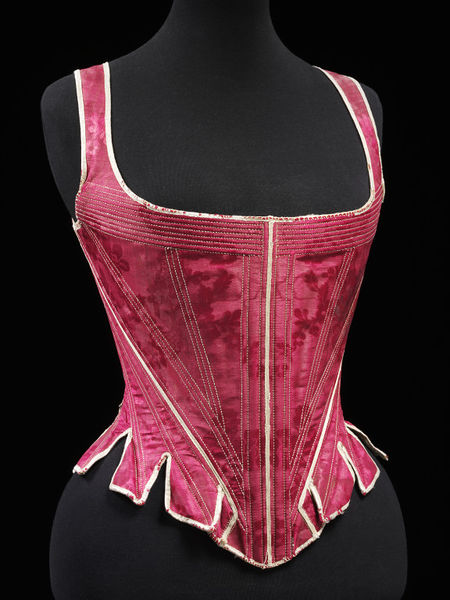
Stays, England, 1770-1790, Silk damask, lined with linen, reinforced with whalebone, hand-sewn, Victoria & Albert Museum, T.909-1913
Long, clear rectangles. Interestingly, all the stays in this book, of every date, have predominantly rectangular tabs with crisp corners, suggesting that triangular and rounded tabs were uncommon in what is now Czechia.
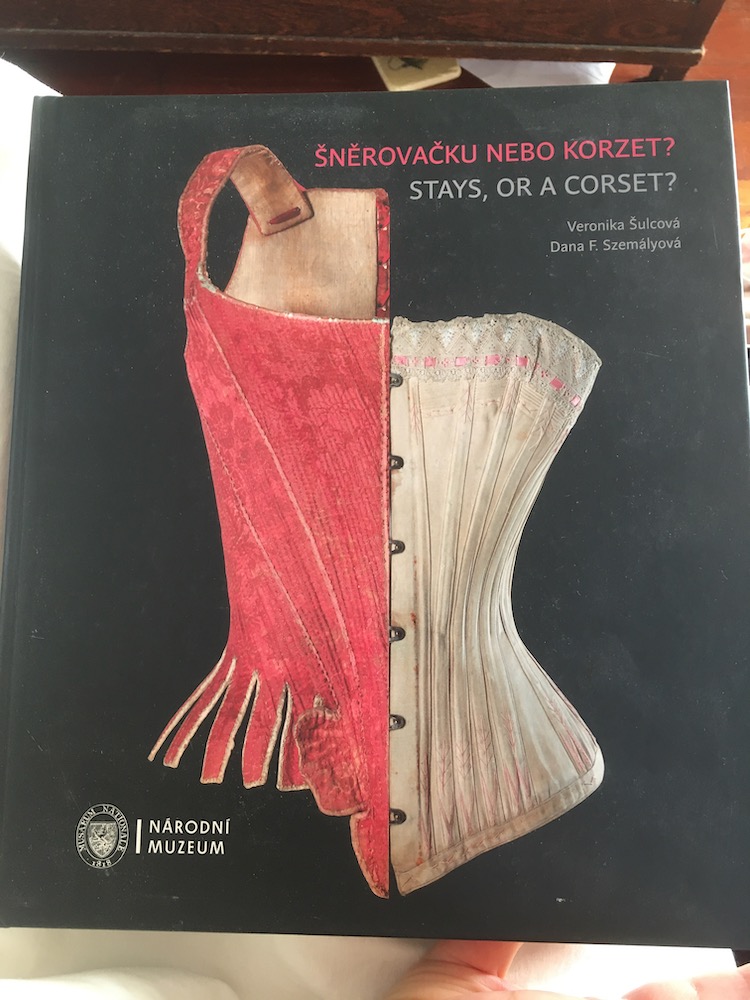
Stays or a Corset, Narodni Muzeum, Czechia – the red pair is 1770-1775
Lovely crisp rectangles. Like the first image, this was intended to be worn as outerwear, and the tabs are wrap-finished, and may be separate pieces.
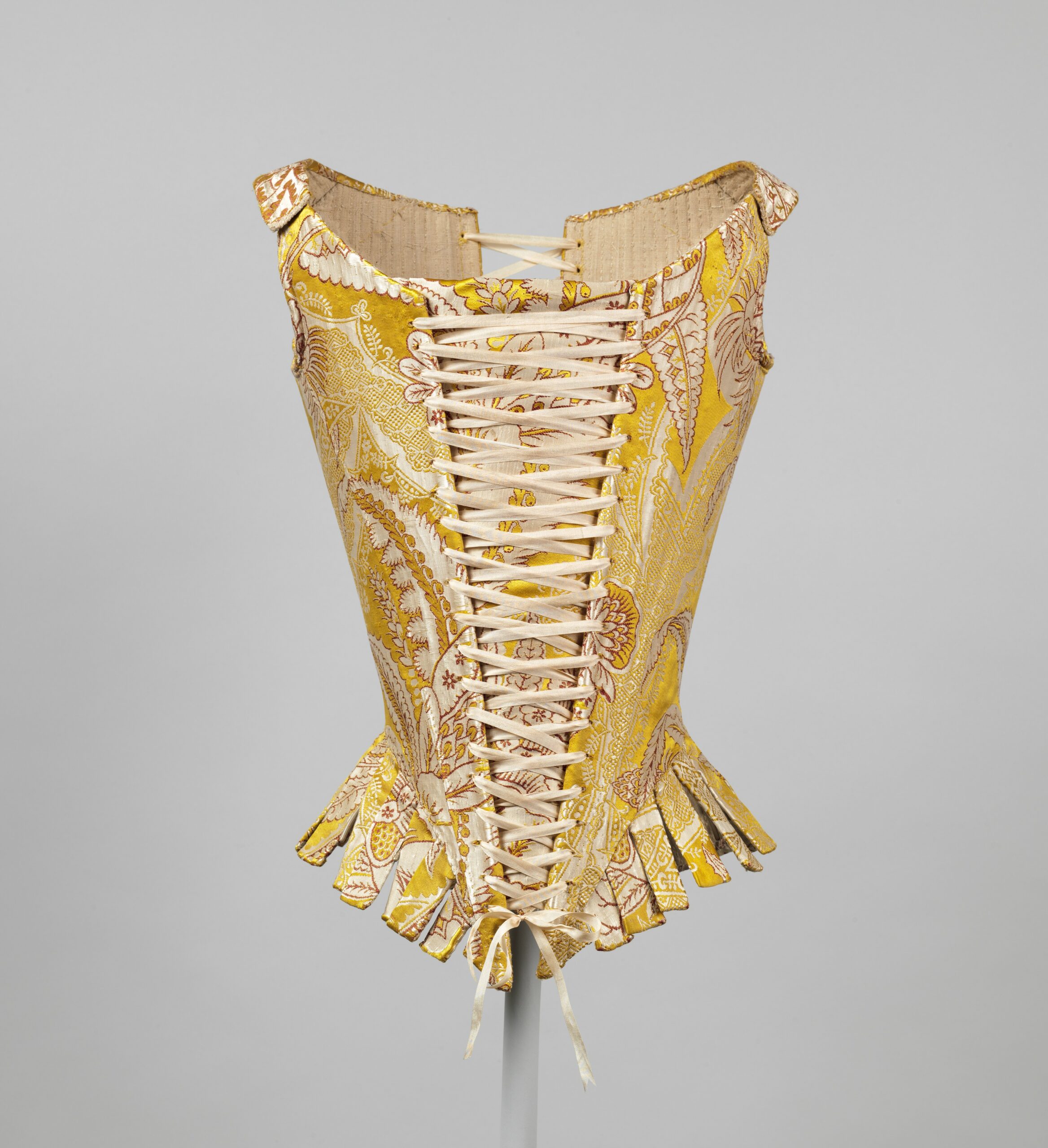
Stays, 1770s, Italian, silk, Gift of The Metropolitan Museum of Art, 1940 C.I.40.173.6a–e
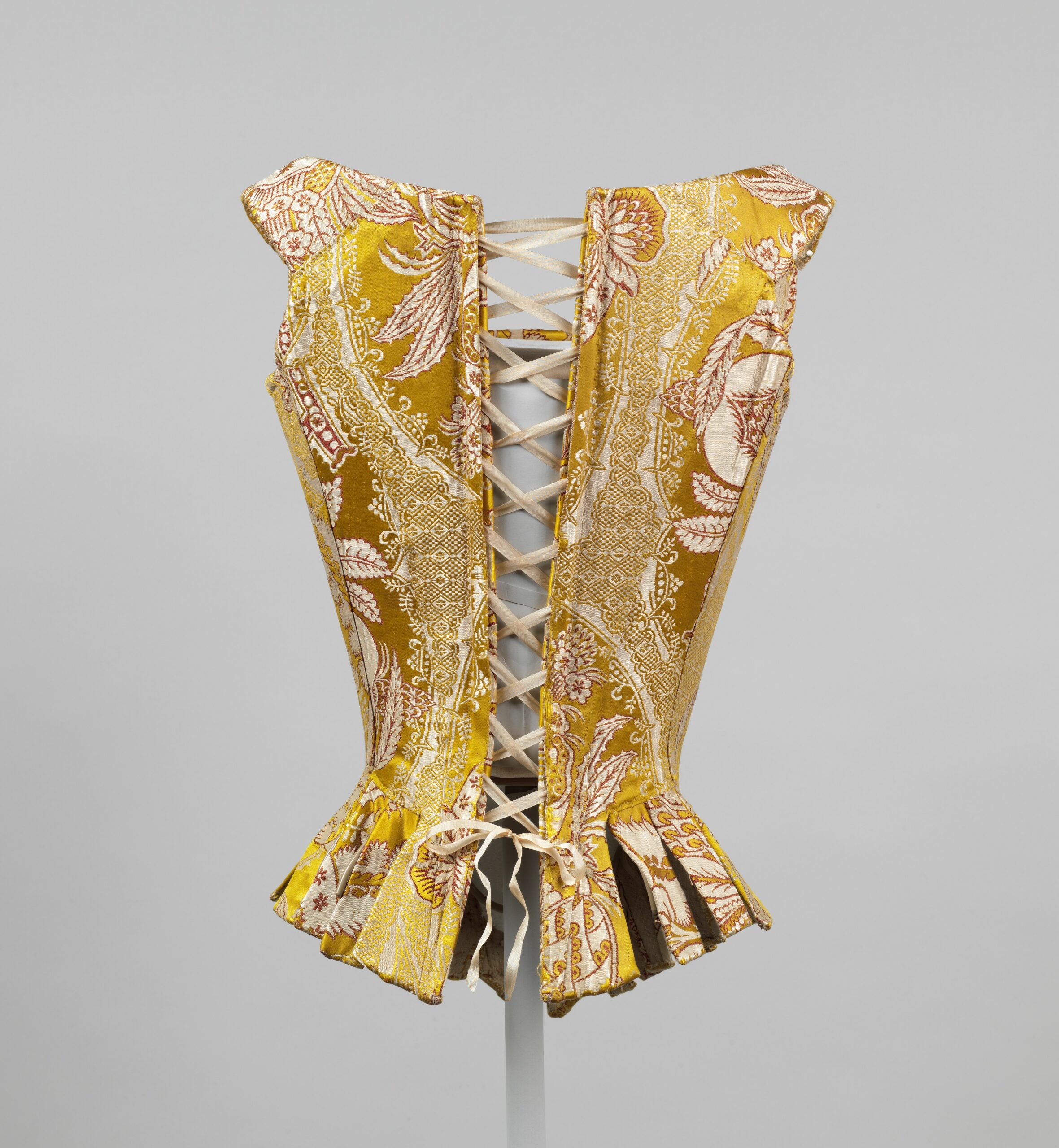
Stays, 1770s, Italian, silk, Gift of The Metropolitan Museum of Art, 1940 C.I.40.173.6a–e
Long, crisp rectangles – and an example of front and back lacing! (although the back lacing looks like the working lacing).
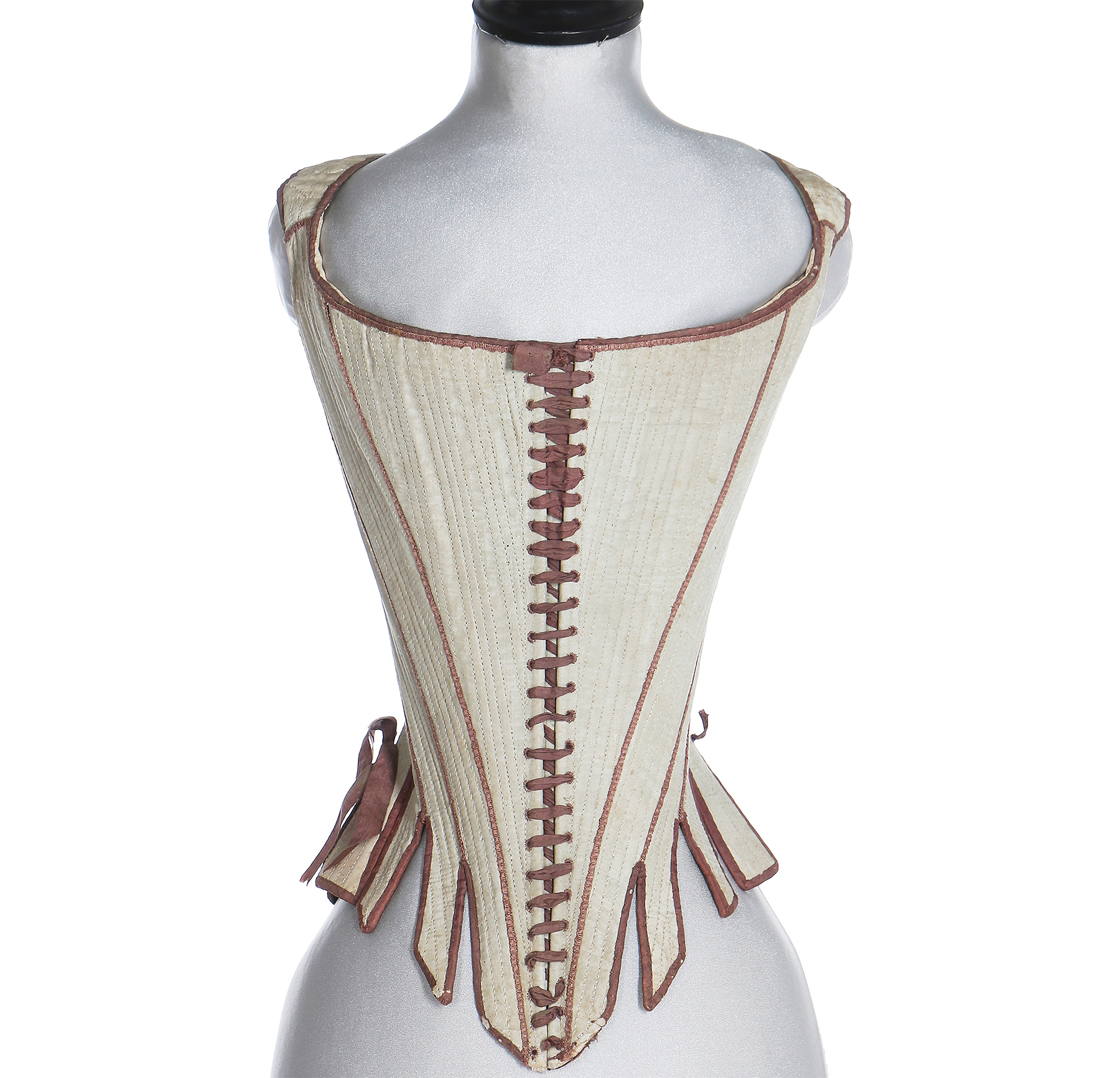
Stays, c.1775-80s, tabs faced in chicken skin, sold at auction
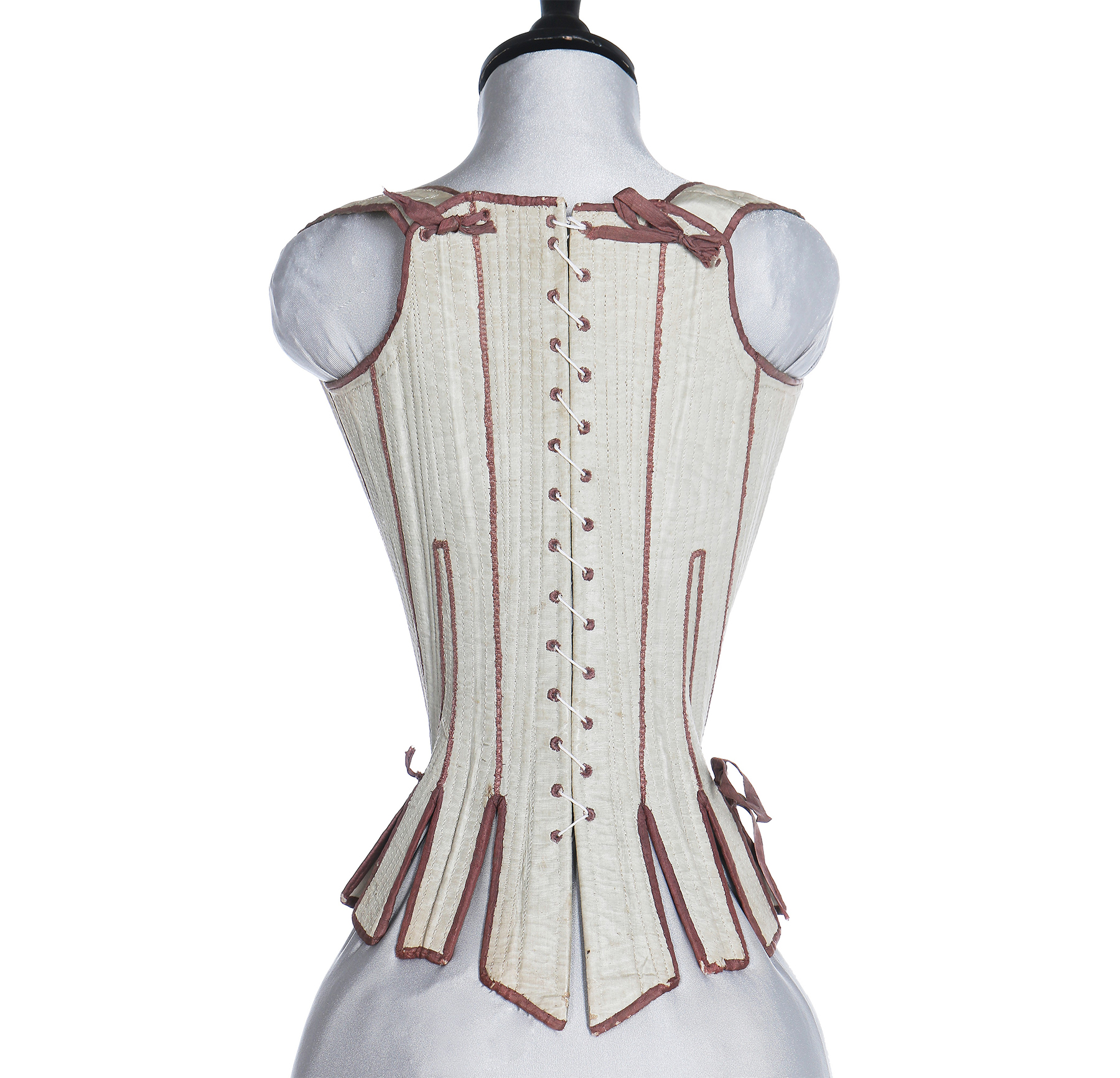
Stays, c.1775-80s, tabs faced in chicken skin, sold at auction
So, crisp rectangular tabs are seen from the very early 18th century, in to the 1780s.
Rounded Rectangles
Moving on to tabs with more rounded corners, we start with an example that could plausibly have been placed in with the sharp cornered examples, as some of the rounding may be age and wear:
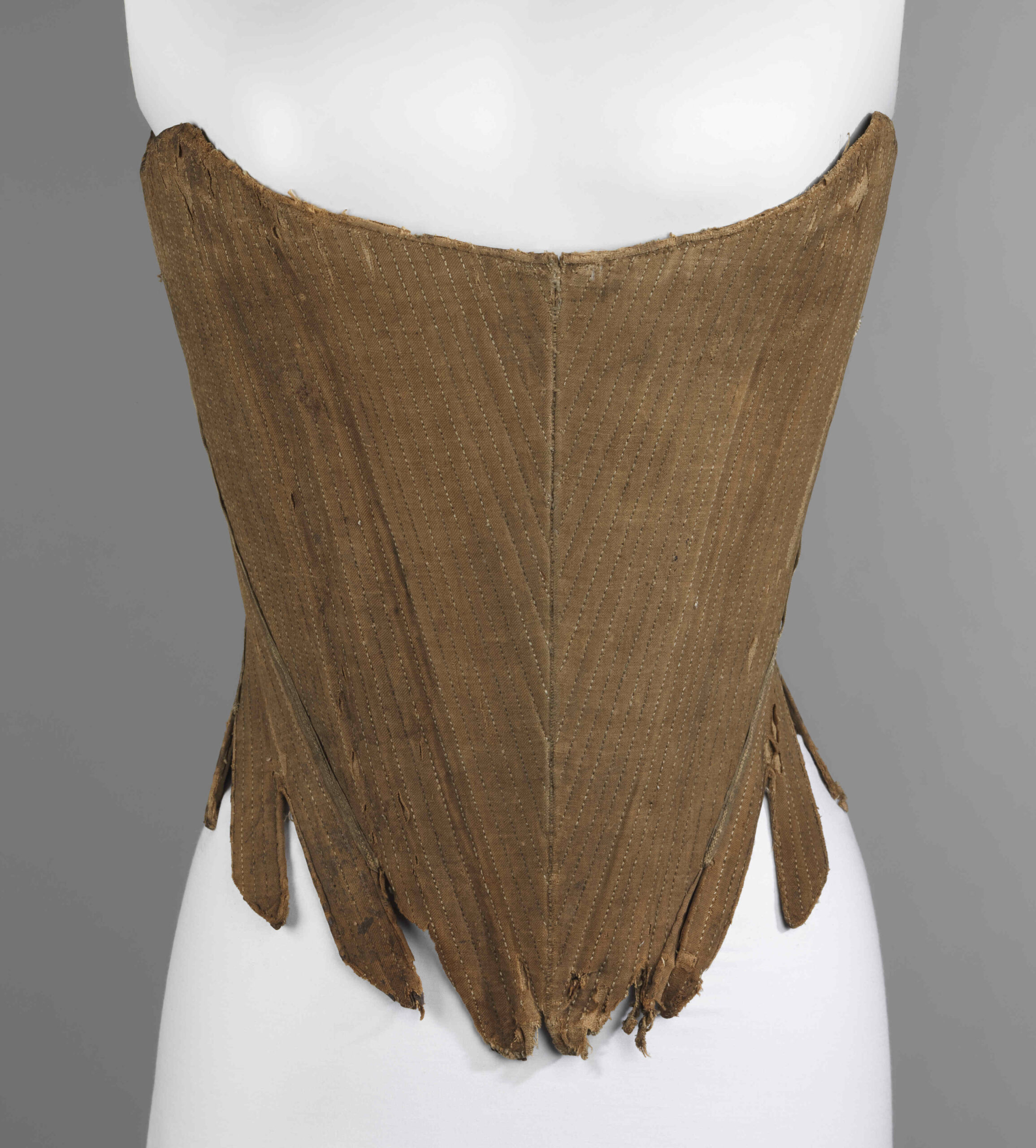
Stays, first quarter 18th century, American, linen, cotton, whalebone, Brooklyn Museum Costume Collection at The Metropolitan Museum of Art, 2009.300.3089
I’d love to know how the Metropolitan Museum of Art arrived at the dating for these stays, as they look much more like mid-18th century examples than any images of late 17th/early 18th c stays that I am aware of, or any extant pairs with very definitive dating.
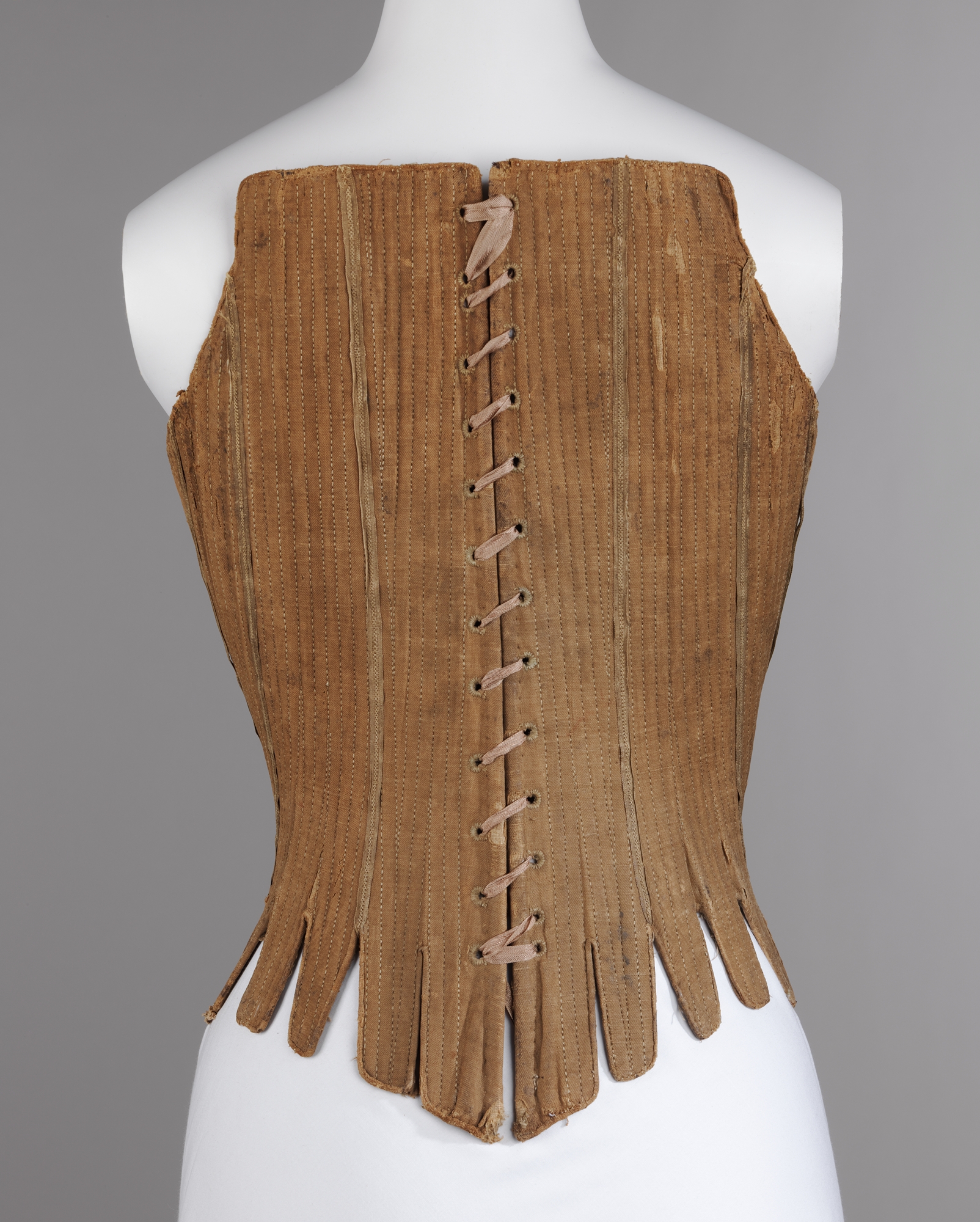
Stays, first quarter 18th century, American, linen, cotton, whalebone, Brooklyn Museum Costume Collection at The Metropolitan Museum of Art, 2009.300.3089
I wish this strikingly coloured pair had a more definite date, but I do like how clearly you can see the tab shape:
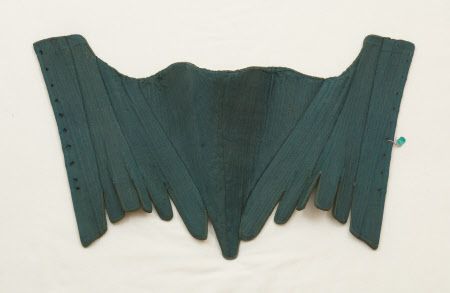
Stays, 1700 – 1750, National Trust, Snowshill Wade Costume Collection, Gloucestershire NT 1349939
You can only see two tabs on this pair, but they are rounded rectangles:
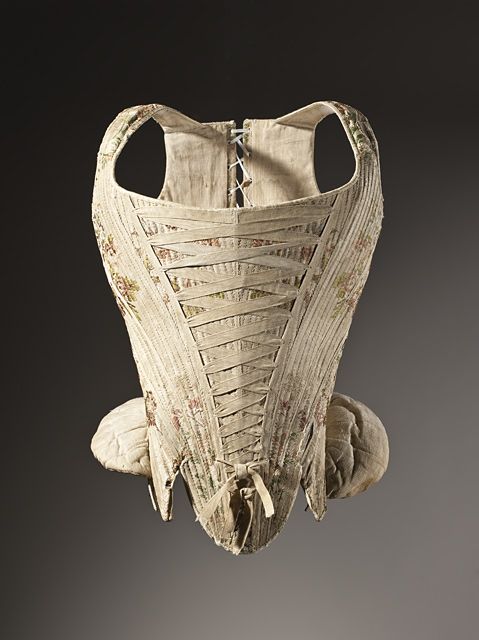
Woman’s Corset (stays), France, circa 1730-1740, Silk plain weave with supplementary weft-float patterning
And all of the stays in Hogarth’s Analysis of Beauty have rounded rectangular tabs – particularly #4, which is the ‘correct’ line!

The Analysis of Beauty, Plate 1, William Hogarth (British, London 1697—1764 London), March 5, 1753, Etching and engraving, Metropolitan Museum of Art, 32.35(22)
Good dating, and very clear tab shape:
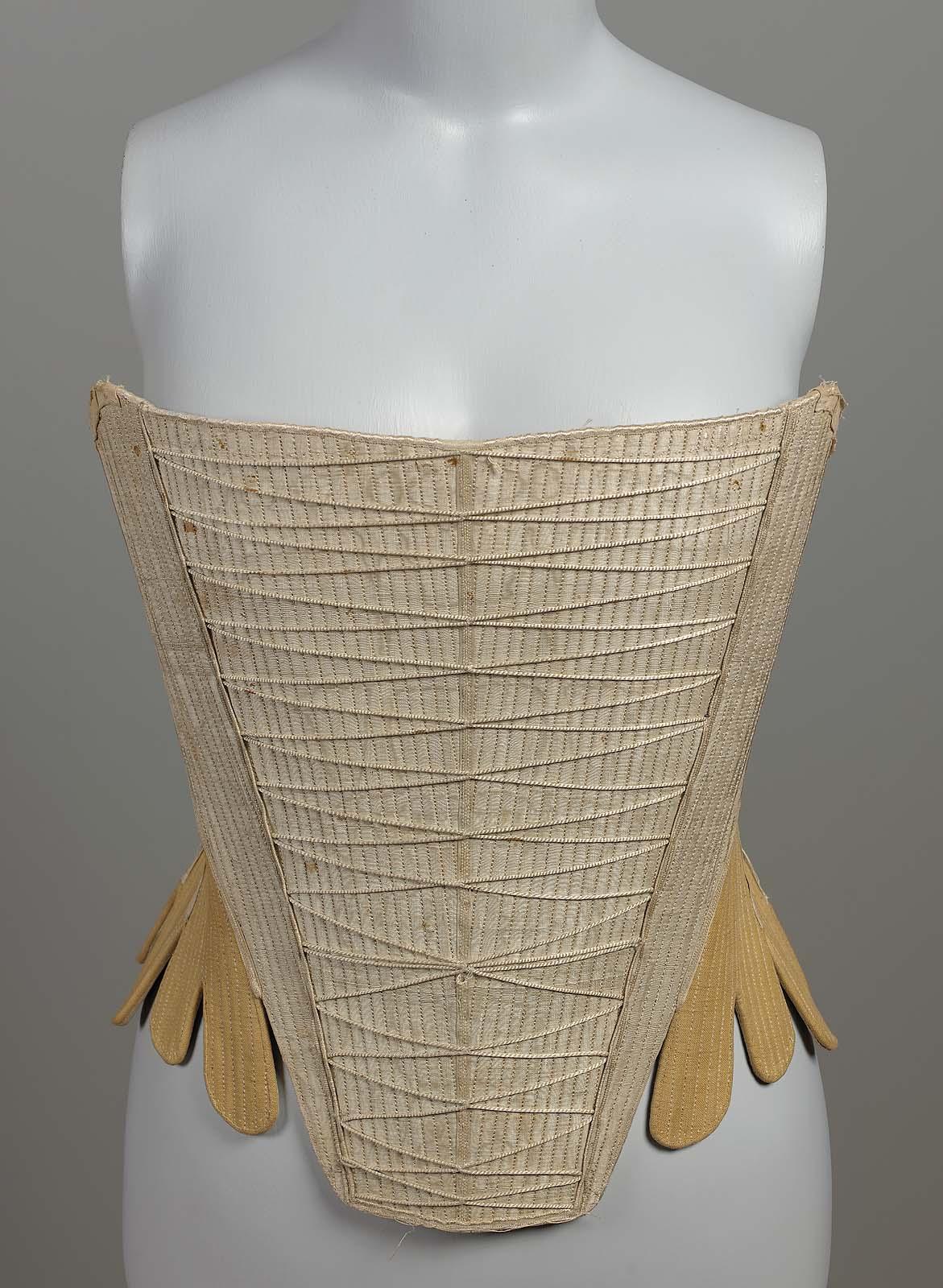
Stays, 1740–60, Massachusettes or New York, USA, White moiré silk rep front, beige linen back; ecru linen lining. White silk ribbon over seams, MFA Boston, 44.347
The side front tabs on this pair, as on many stays, are trapezoids, but all the other tabs are rounded rectangles:
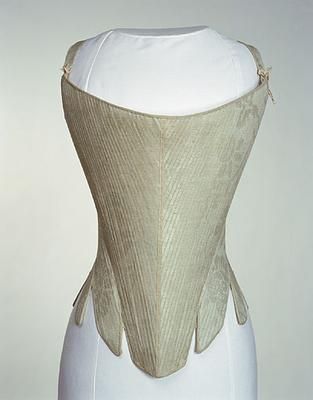
Stays, United Kingdom, 1740-1760, 1947.1622, Manchester City Galleries

Corset (Stays), 1740–60, American, linen, leather, whalebone, Brooklyn Museum Costume Collection at The Metropolitan Museum of Art, Gift of the Jason and Peggy Westerfield Collection, 1969, 2009.300.3330a–d
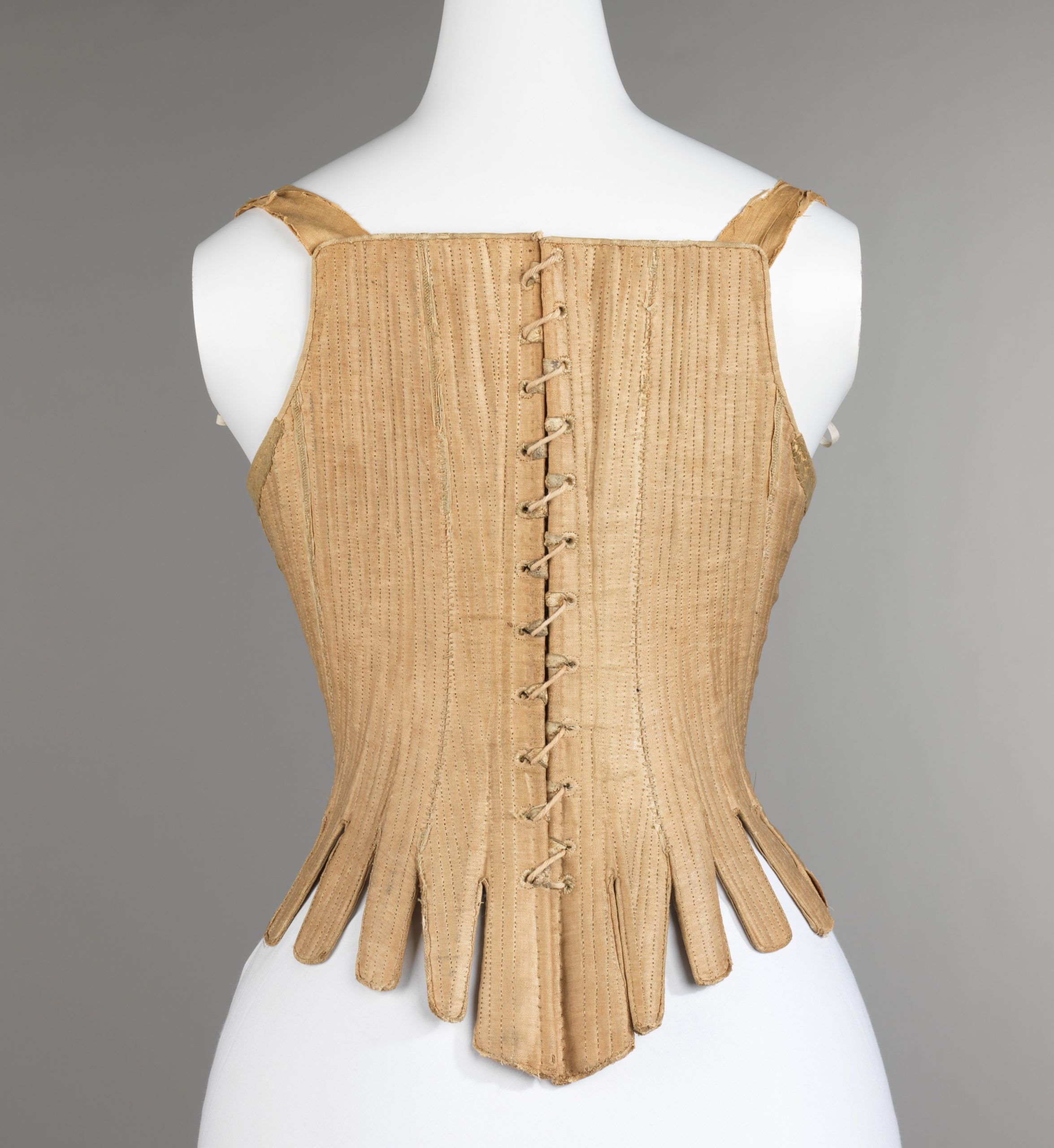
Corset (Stays), 1740–60, American, linen, leather, whalebone, Brooklyn Museum Costume Collection at The Metropolitan Museum of Art, Gift of the Jason and Peggy Westerfield Collection, 1969, 2009.300.3330a–d
Very rounded rectangles:
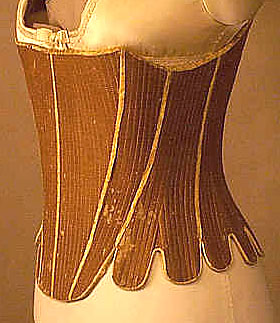
Stays, 18th C. (c. 1750-60) sold by antique.fashions
And the shape continues in to the mid-century:
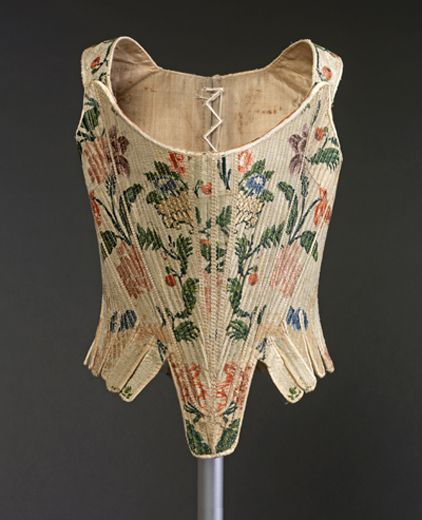
Spanish Stays, ca 1750
This pair has a very interesting front treatment, and then rounded tabs:
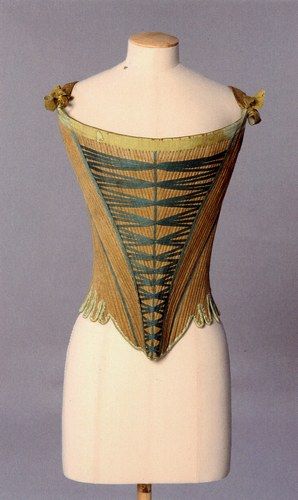
Corset (stays) with green thread trimming, ca. 1755
And here’s another boned bodice/court bodice, this one with rounded rectangular tabs:
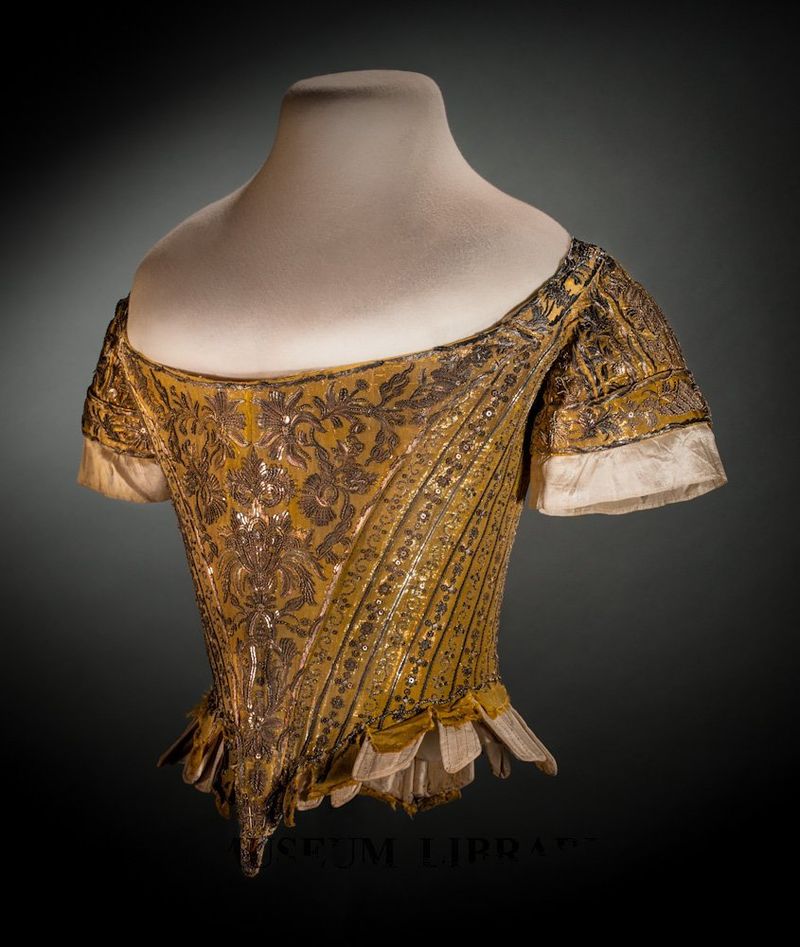
Court Bodice, 1761, Helen Larson Historic Fashion Collection, FIDM
Again the broad front point seen on some mid-century stays, and then short rounded rectangular tabs:
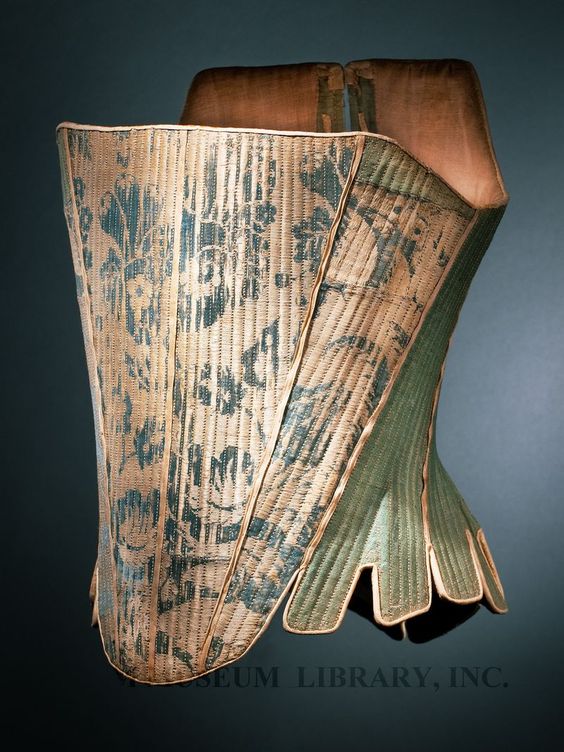
Stays, Europe, c. 1765 Helen Larson Historic Fashion Collection Proposed FIDM Museum Acquisition L2011.13.79
This pair of stays has borderline triangular shapes on the two front tabs, and then rectangular shapes for the rest.
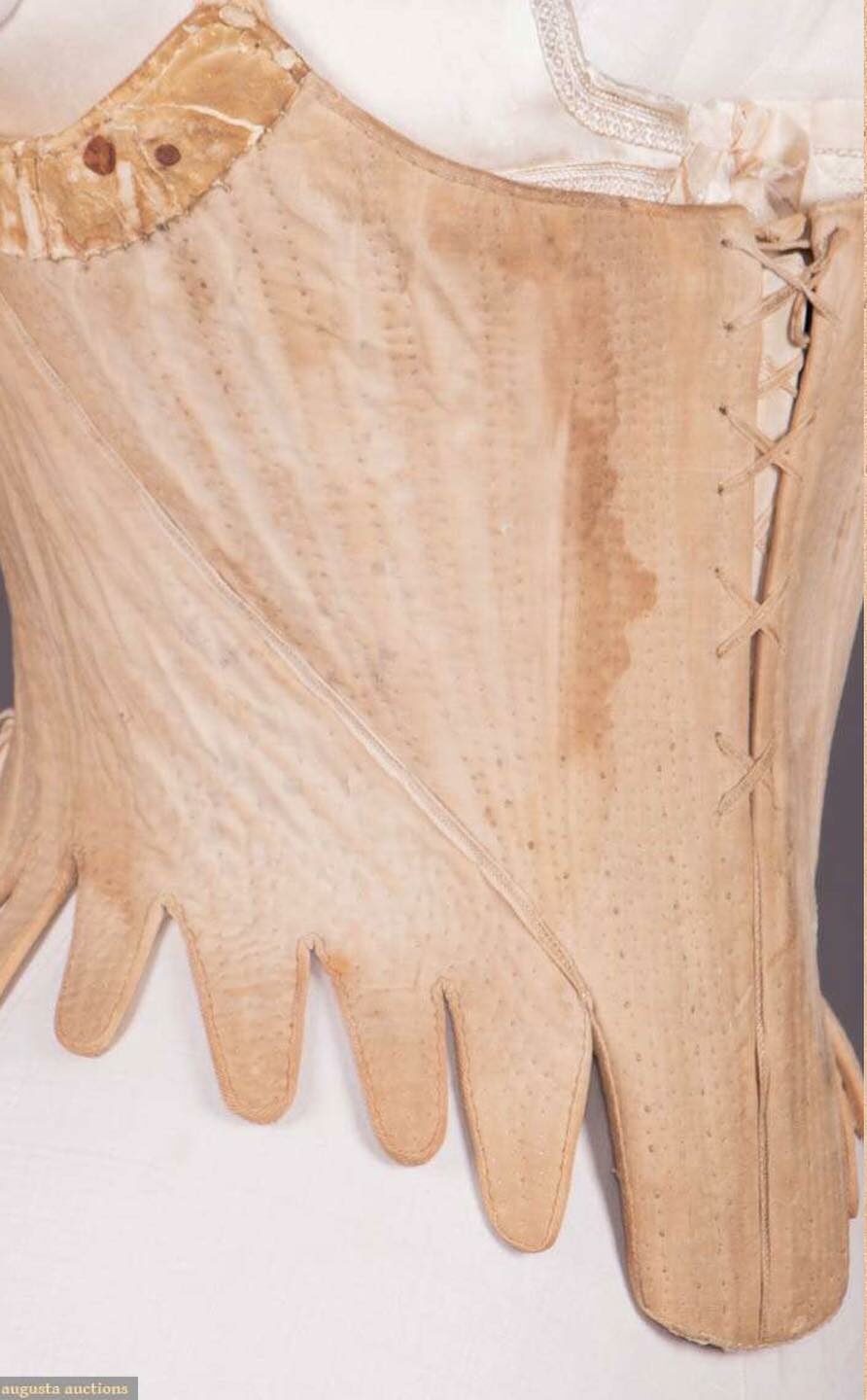
Stays, Italy or Spain, 1760s Sold May 10, 2022 Sturbridge, MA Linen whalebone stays with steel under bust form and velum underarm reinforcements,
I’m not 100% convinced by the 1760s dating. The boning layout, overall shape, and use of underarm reinforcements are all closer to elements seen on stays dated to the 1780s than on any other example of 1760s stays I am familiar with.
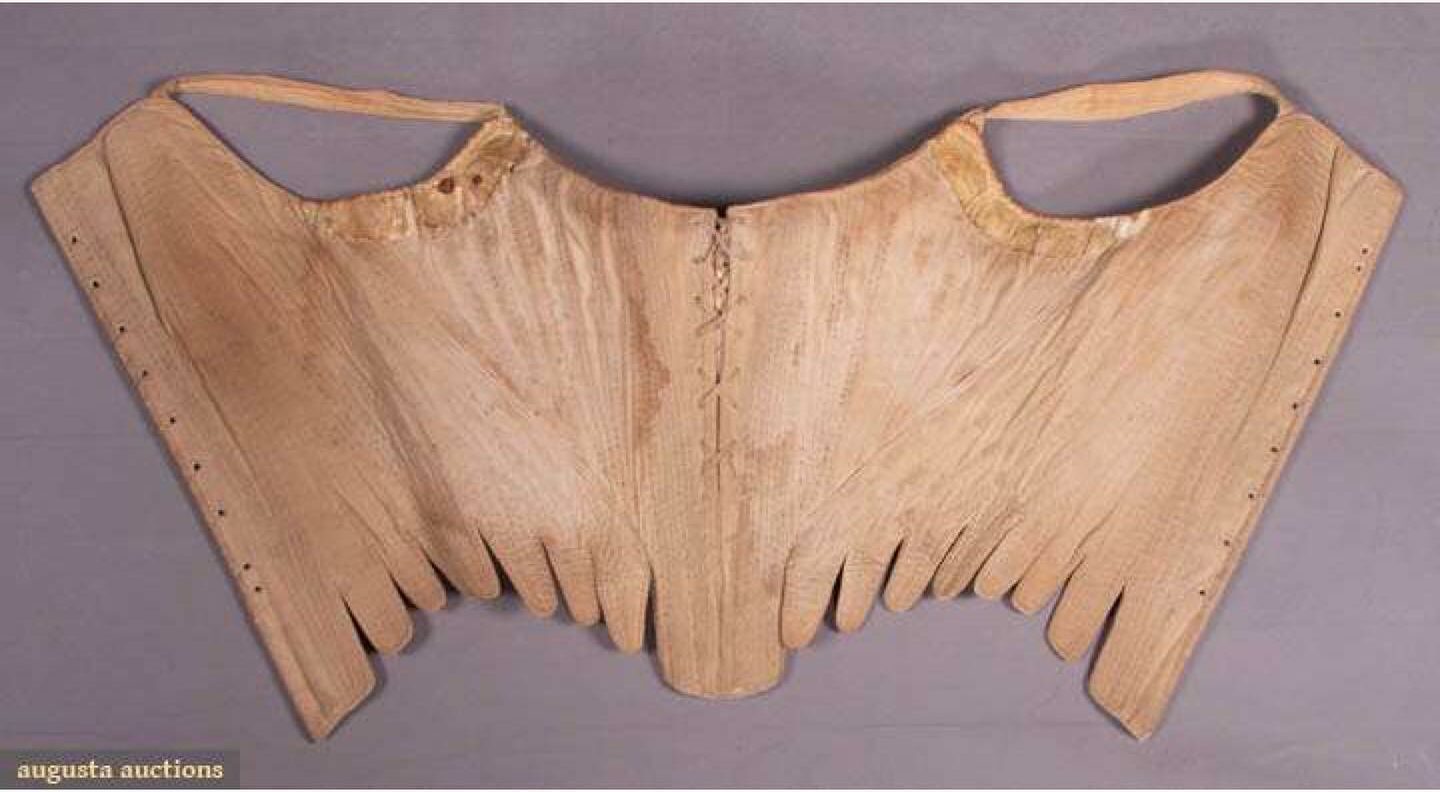
Stays, Italy or Spain, 1760s Sold May 10, 2022 Sturbridge, MA Linen whalebone stays with steel under bust form and velum underarm reinforcements
They certainly have some fascinating elements, like the prick-stitch boning channels.

Stays, Italy or Spain, 1760s Sold May 10, 2022 Sturbridge, MA Linen whalebone stays with steel under bust form and velum underarm reinforcements
This pair of stays is entirely consistent with its given date (and properly laced, ahem), and has very rounded tabs:
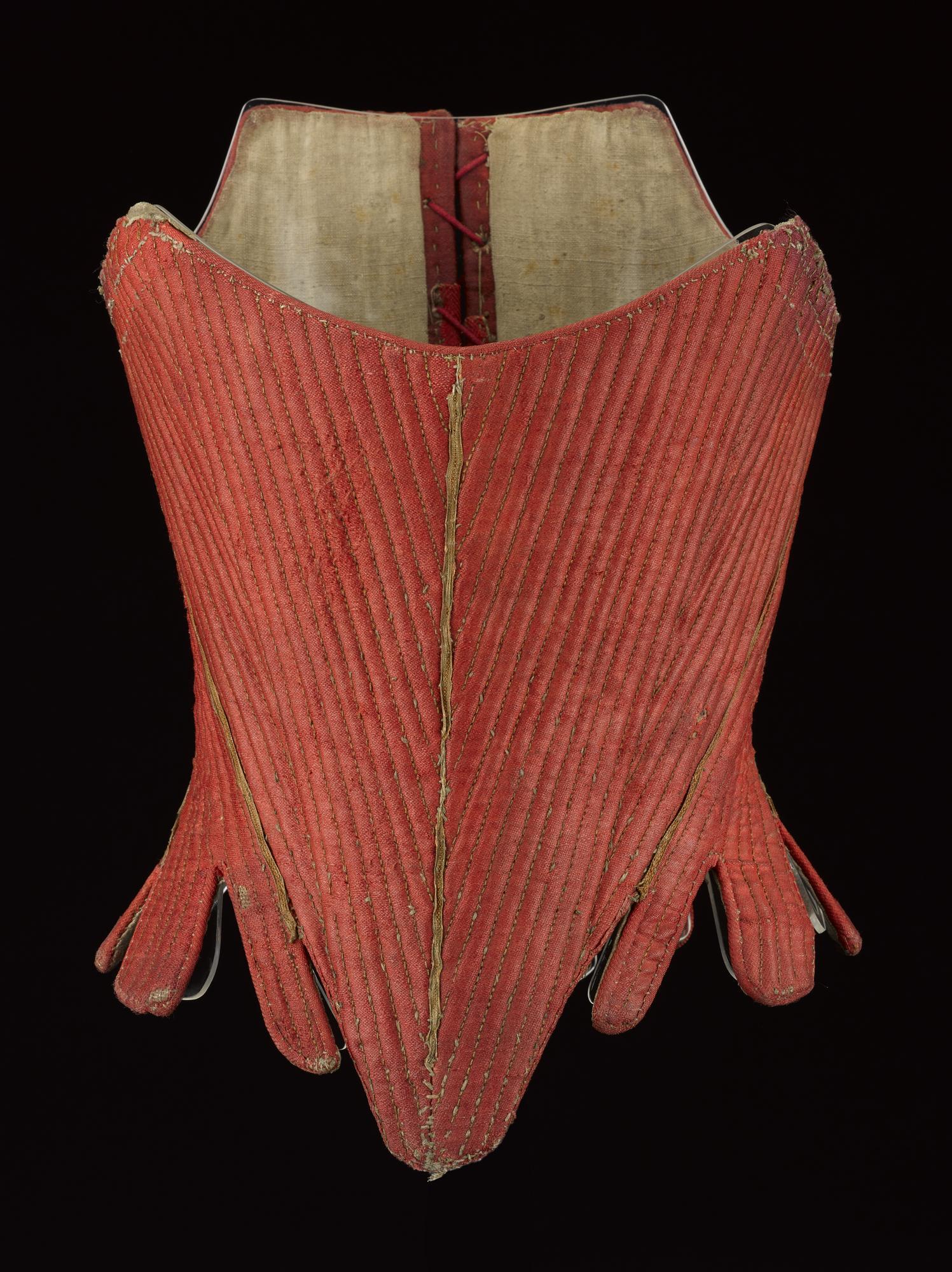
Stays, National Museum Scotland, Linen & Cane, 1765-75 A.1905.983
This pair has those almost triangular side-front points, but the rest are rectangular:
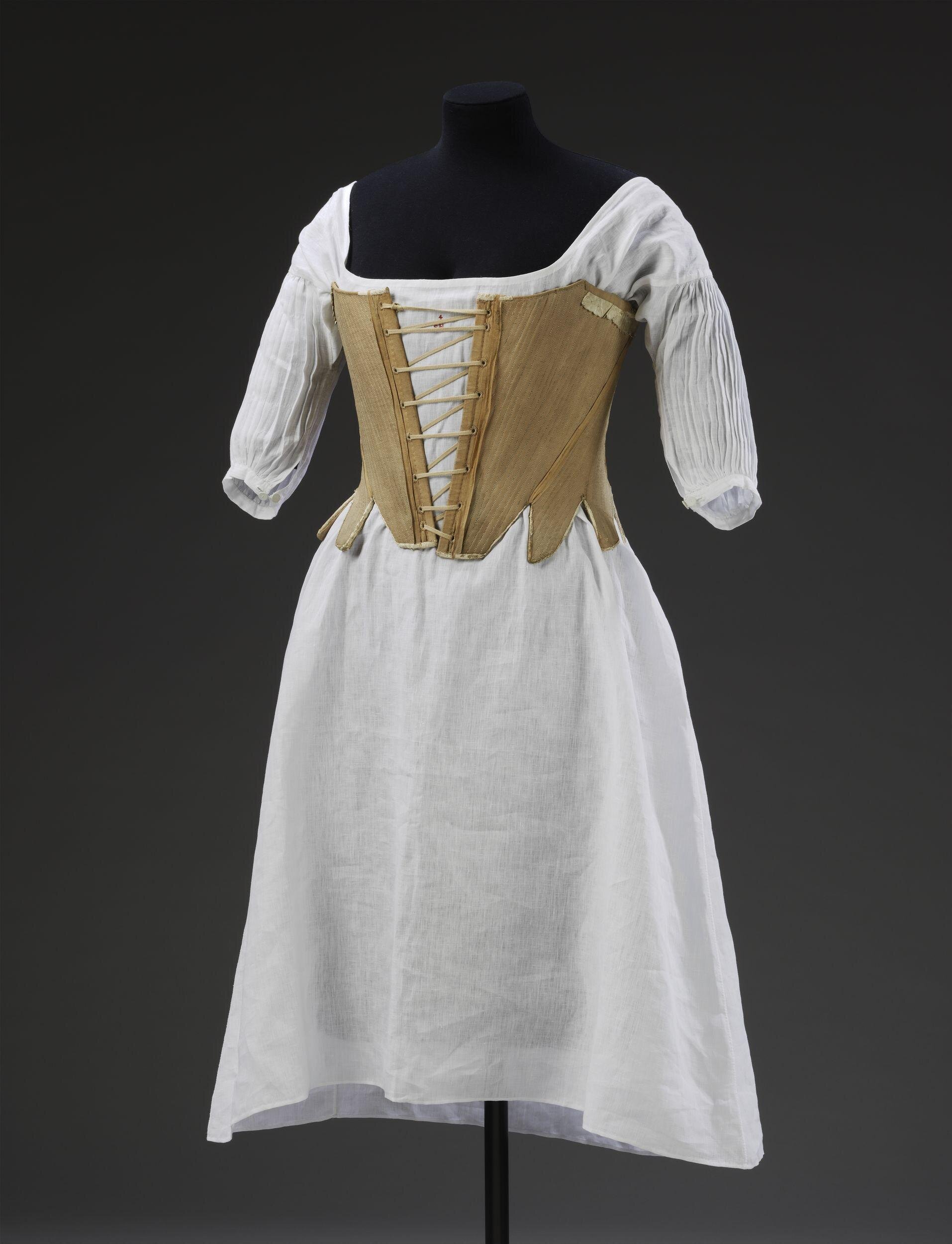
Woman’s stays, probably 1770s, British; Unbleached linen, baleen, edged with leather, front-opening, altered 1780s V&A T911.1913
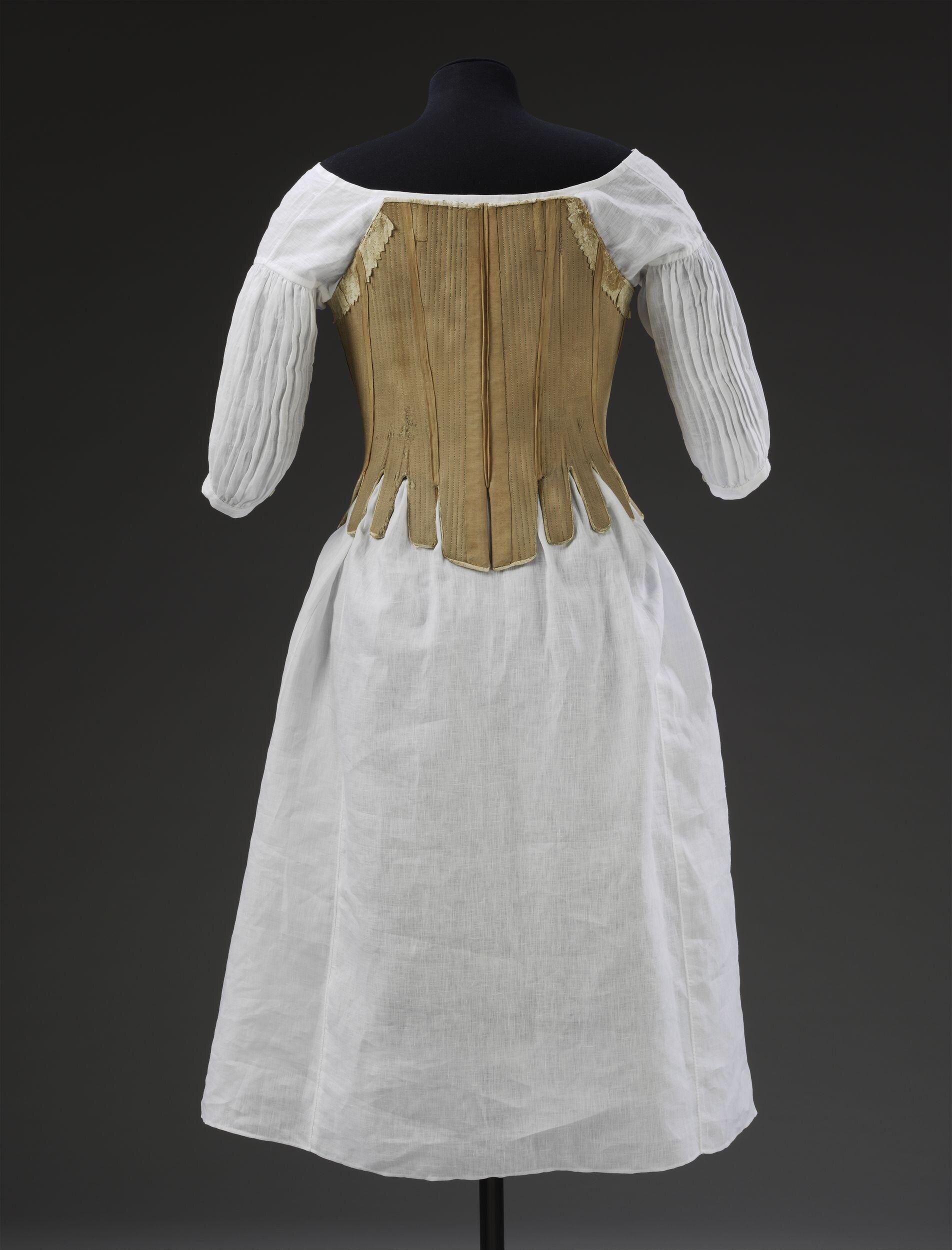
Woman’s stays, probably 1770s, British; Unbleached linen, baleen, edged with leather, front-opening, altered 1780s V&A T911.1913
And the same here. I would suggest this pair is either quite old-fashioned, or at the earliest end of its dating range:
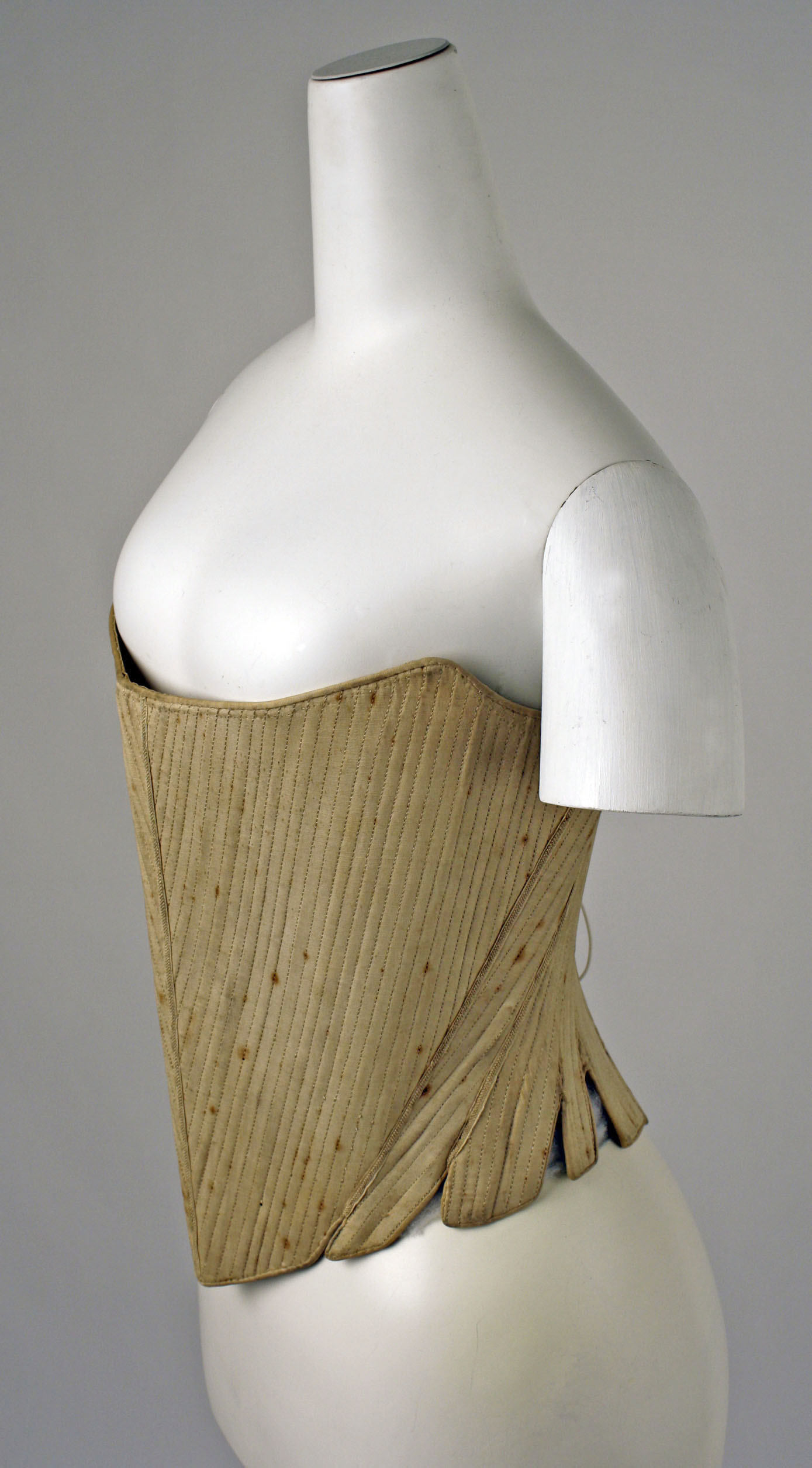
Stays, third quarter 18th century, American, cotton Metropolitan Museum of Art, C.I.66.24.2
(why, oh why, for all the effort to photograph, can’t the stagers figure out how to lace properly!)

Stays, third quarter 18th century, American, cotton Metropolitan Museum of Art, C.I.66.24.2
This pair appears to be indigo dyed, which makes me wonder if it ever rubbed off on the shift or garment lining. Like the stays above, I think it’s more late 1760s-1770s in style than 1780s or 90s.
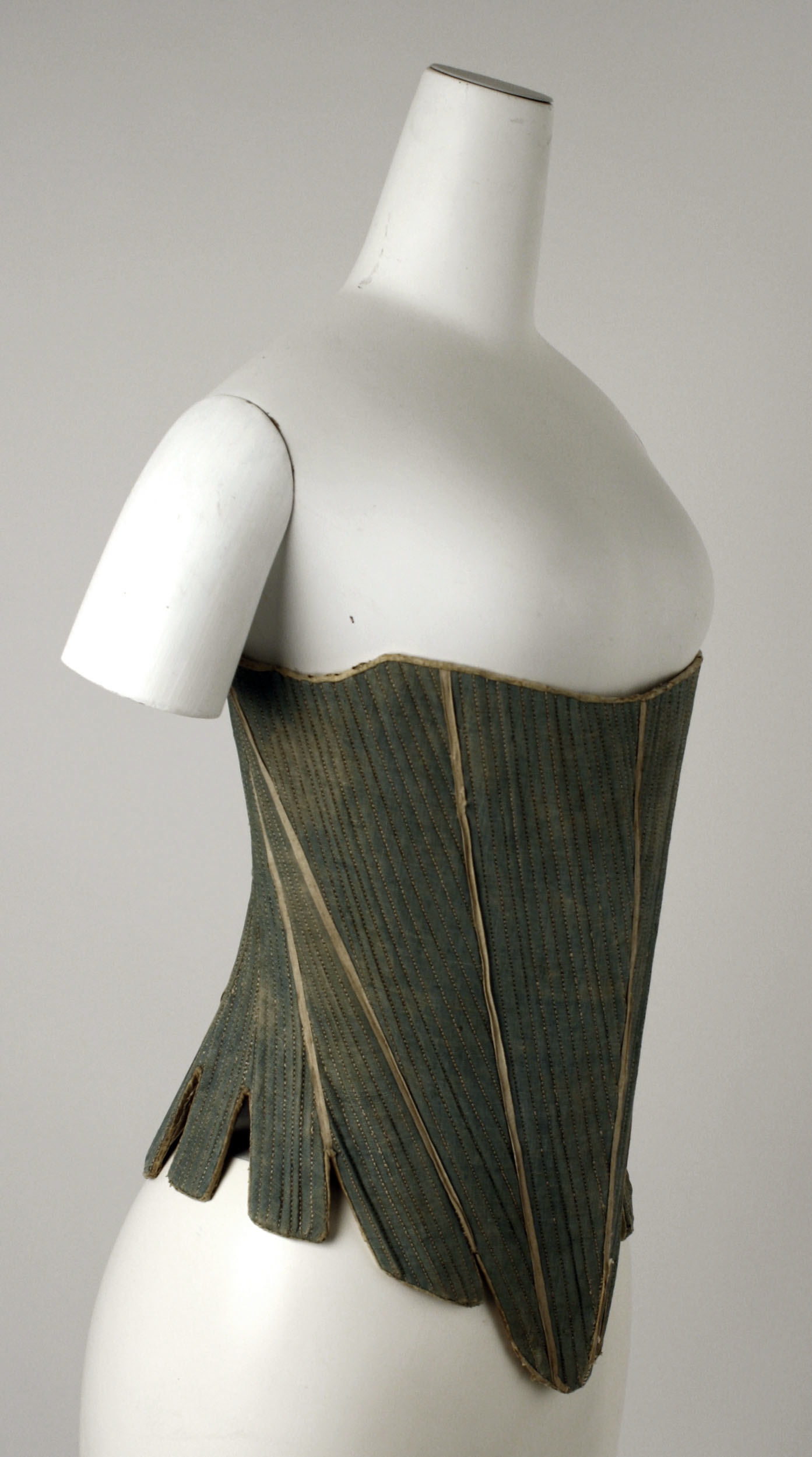
Stays, third quarter 18th century, American, flax, cotton, leather, wood Gift of Jacqueline Loewe Fowler, 1983, Metropolitan Museum of Art, 1983.213.4
I have similar feelings about the dating of this pair. The finish of the top edge is interesting:
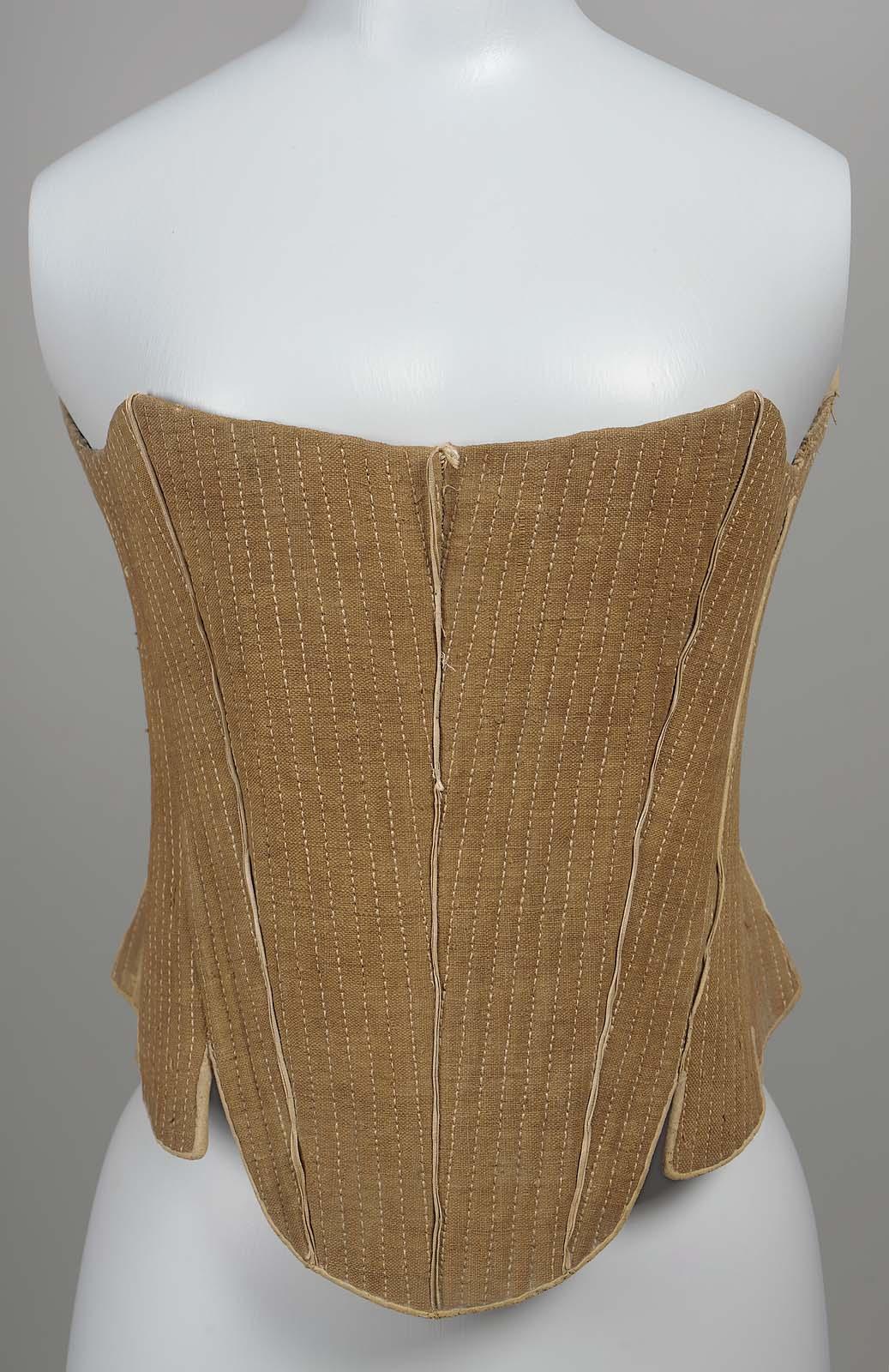
Stays, American, last quarter of the 18th century, United States Metropolitan Museum of Art, 53.941
Stunning, perfectly dated, and with those trapezoidal front points and rounded rectangle tabs:
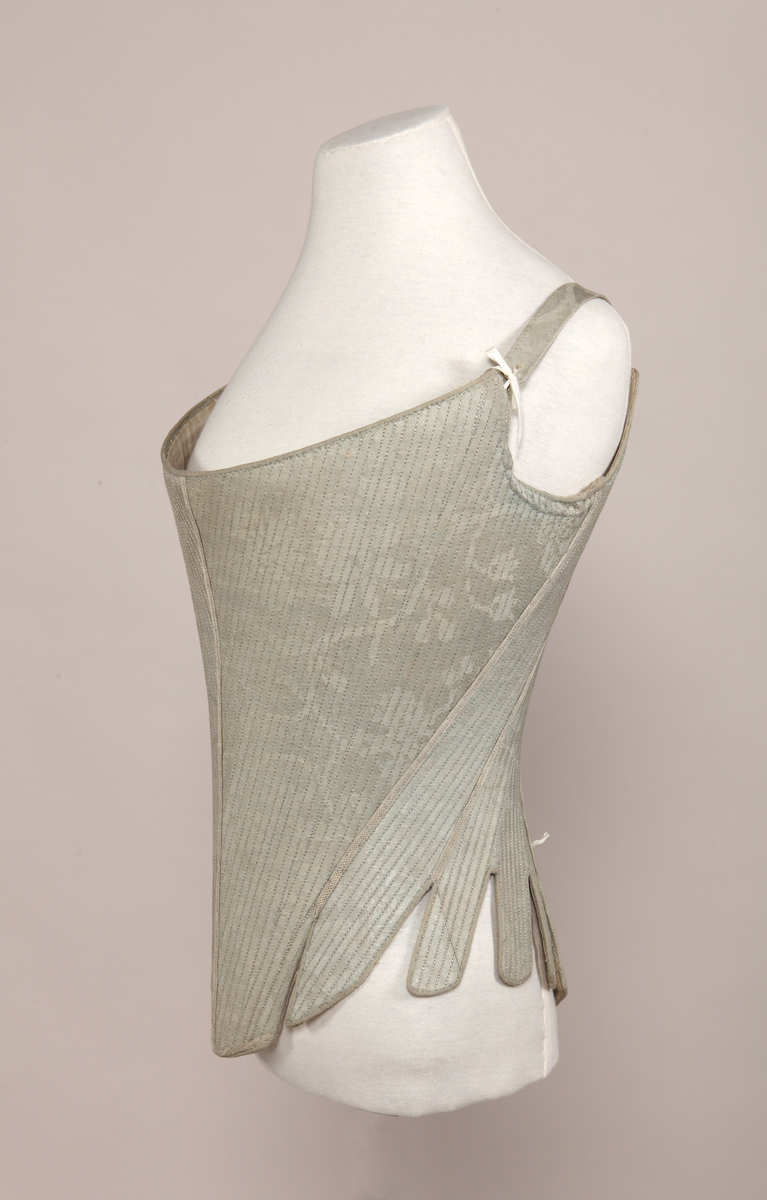
Stays, Pale blue glazed woollen damask over stiff foundation, lined with white linen. Bound with pale blue twilled wool, probably 1770s, 1947.1622 Manchester Art Gallery
Rectangle tabs all round on this half-boned pair with back-tying straps and a lovely yellow shade:
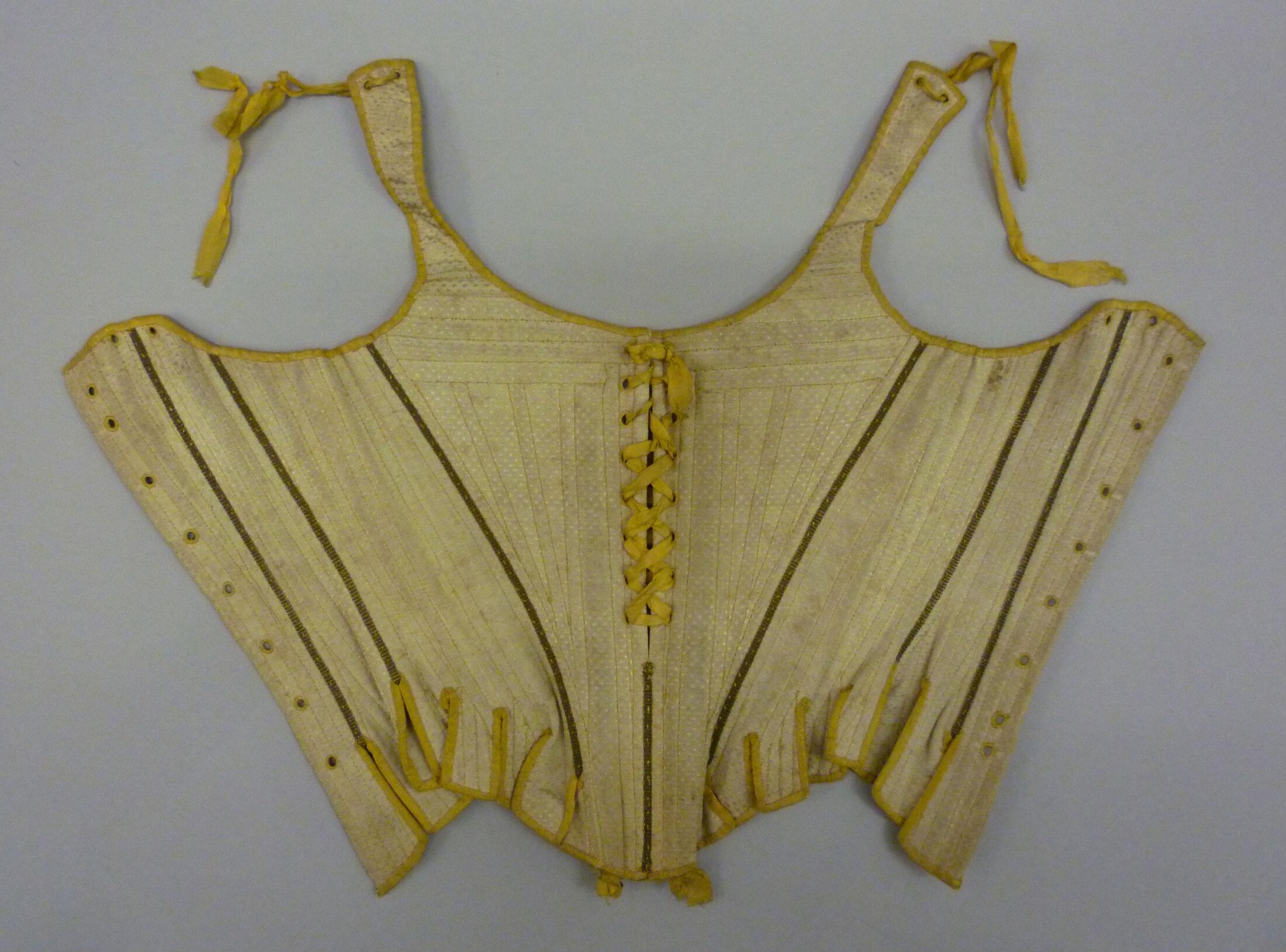
Woman’s stays, 1770s, British; ivory figured silk, yellow silk trim, sample or apprentice piece, V&A T910.1913
And the same here on this fantastic pair which are so similar to the front-lacing Cassandras.
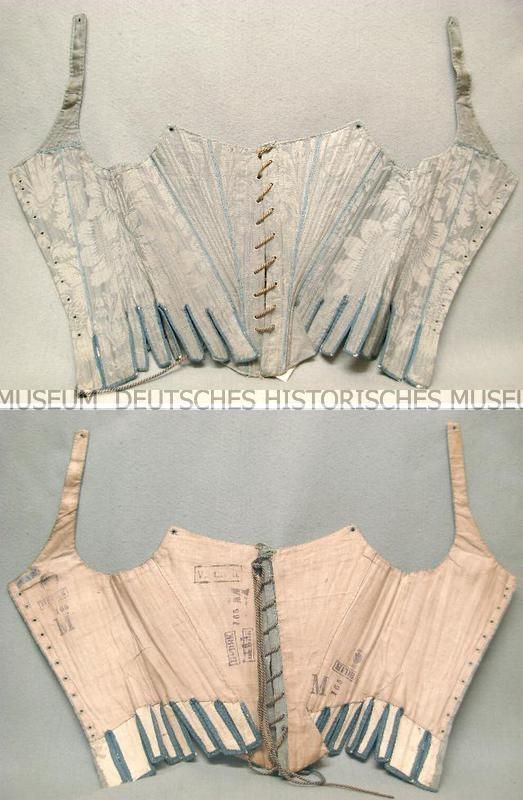
Stays, probably 1770s, Germany
Moving into the 1780s, a classic shape for that era, interesting half-boning, and rounded rectangle tabs:
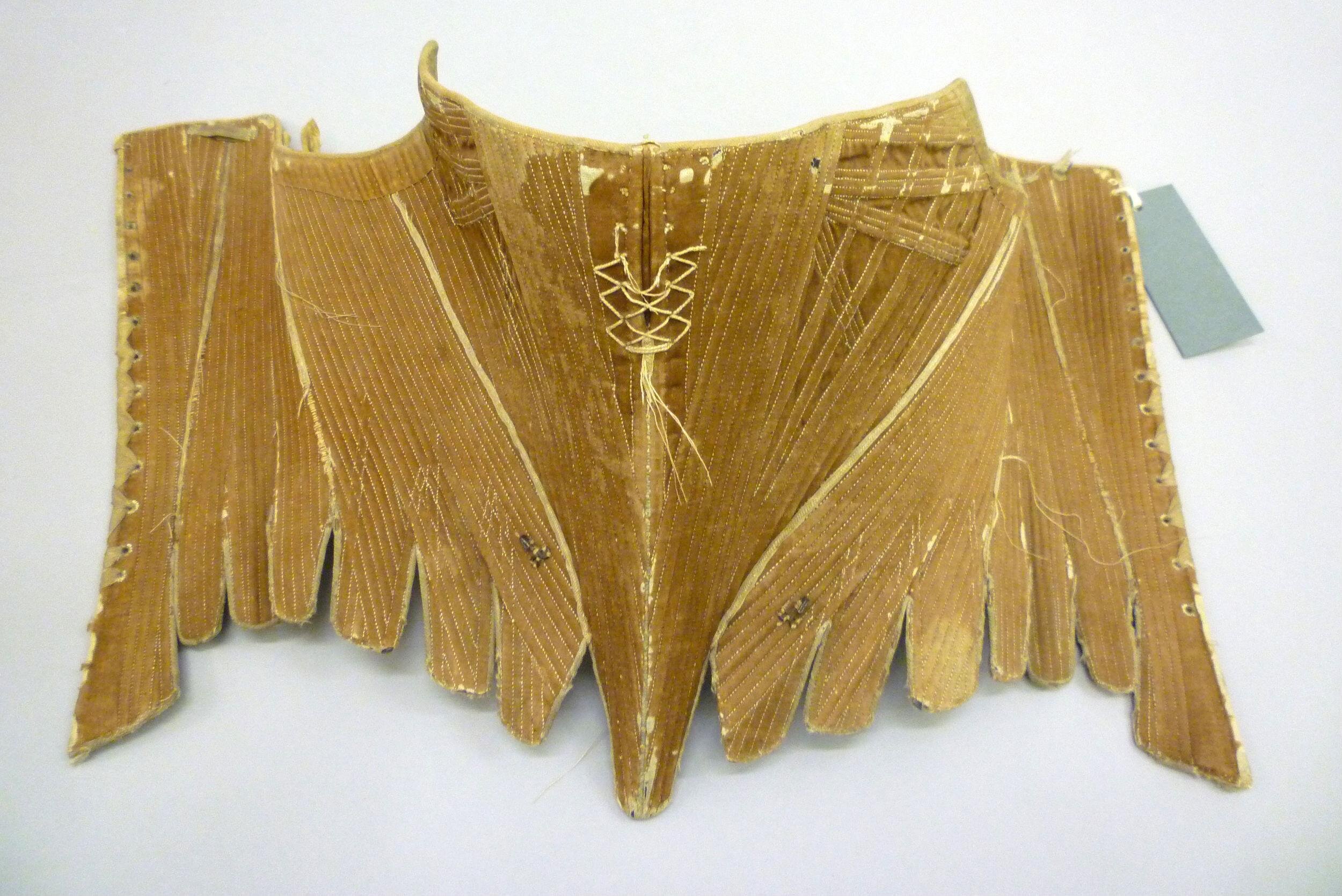
Woman’s brown linen stays, 1780s, British; lined with linen, back lacing V&A T913.1913
And similarly:
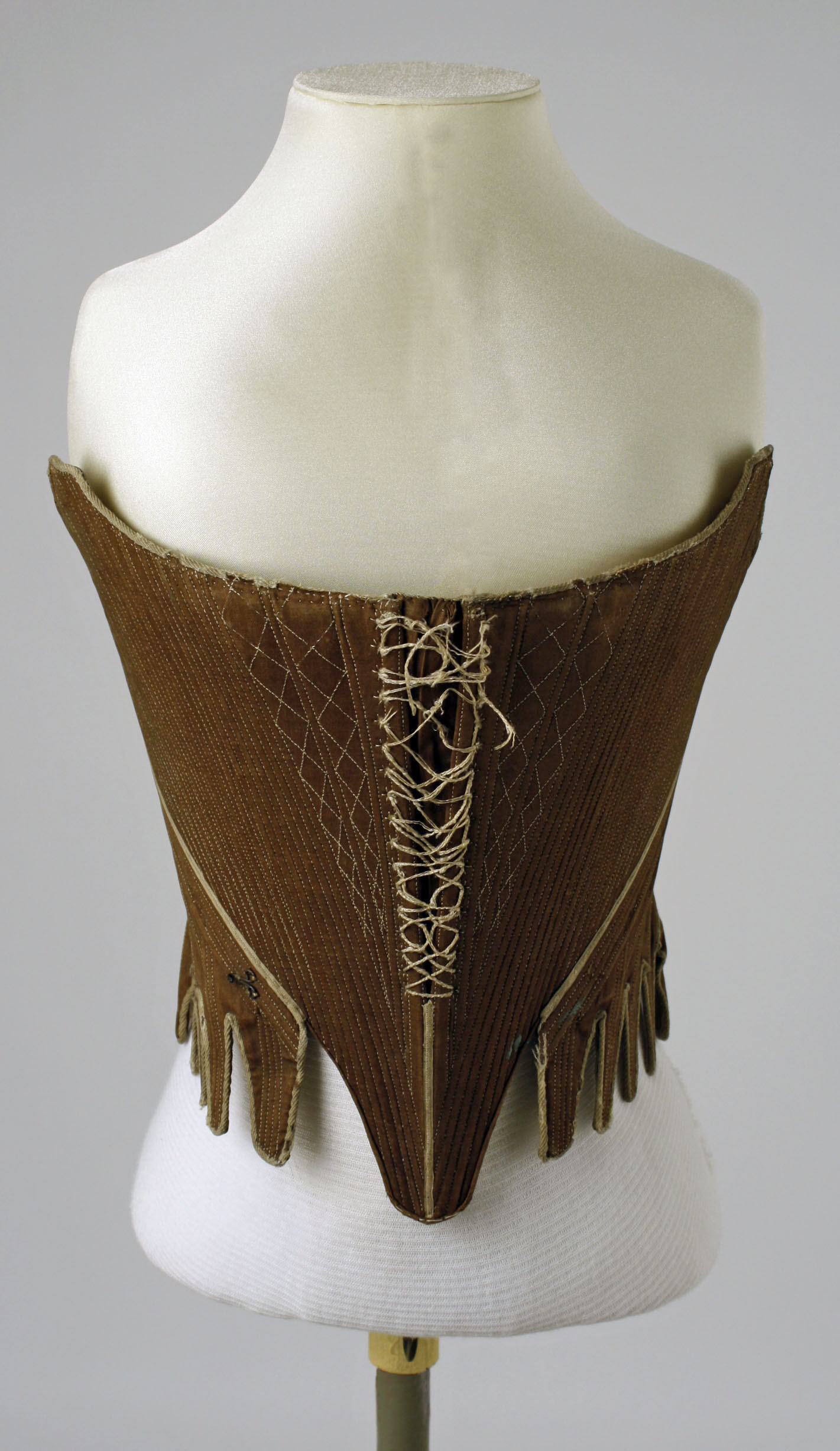
Stays, ca. 1780, British, cotton, flax, wood, metal, Metropolitan Museum of Art, 1984.8
Another great front-and-back lacing example with rounded-rectangle tabs:
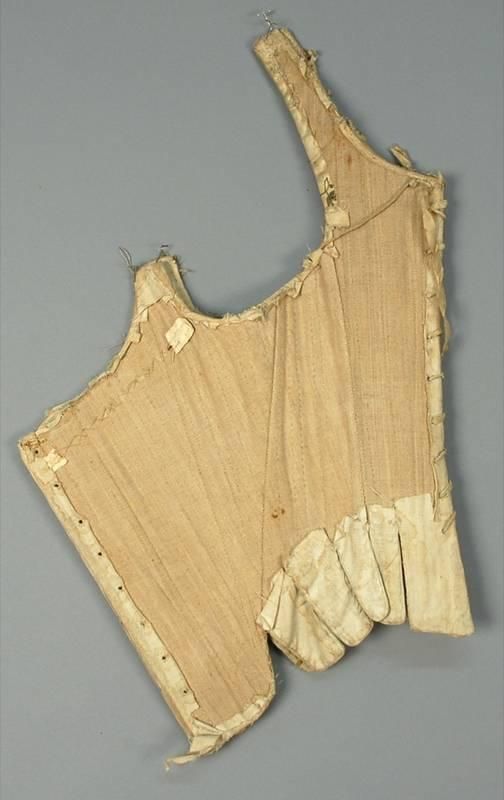
Stays with metallic embroidery, Italian, c. 1780, sold by Whittaker Auctions
Stunning shaping to the bust line of this pair, beautiful even tabs, and evidence that it once had narrow wrapping tie straps.
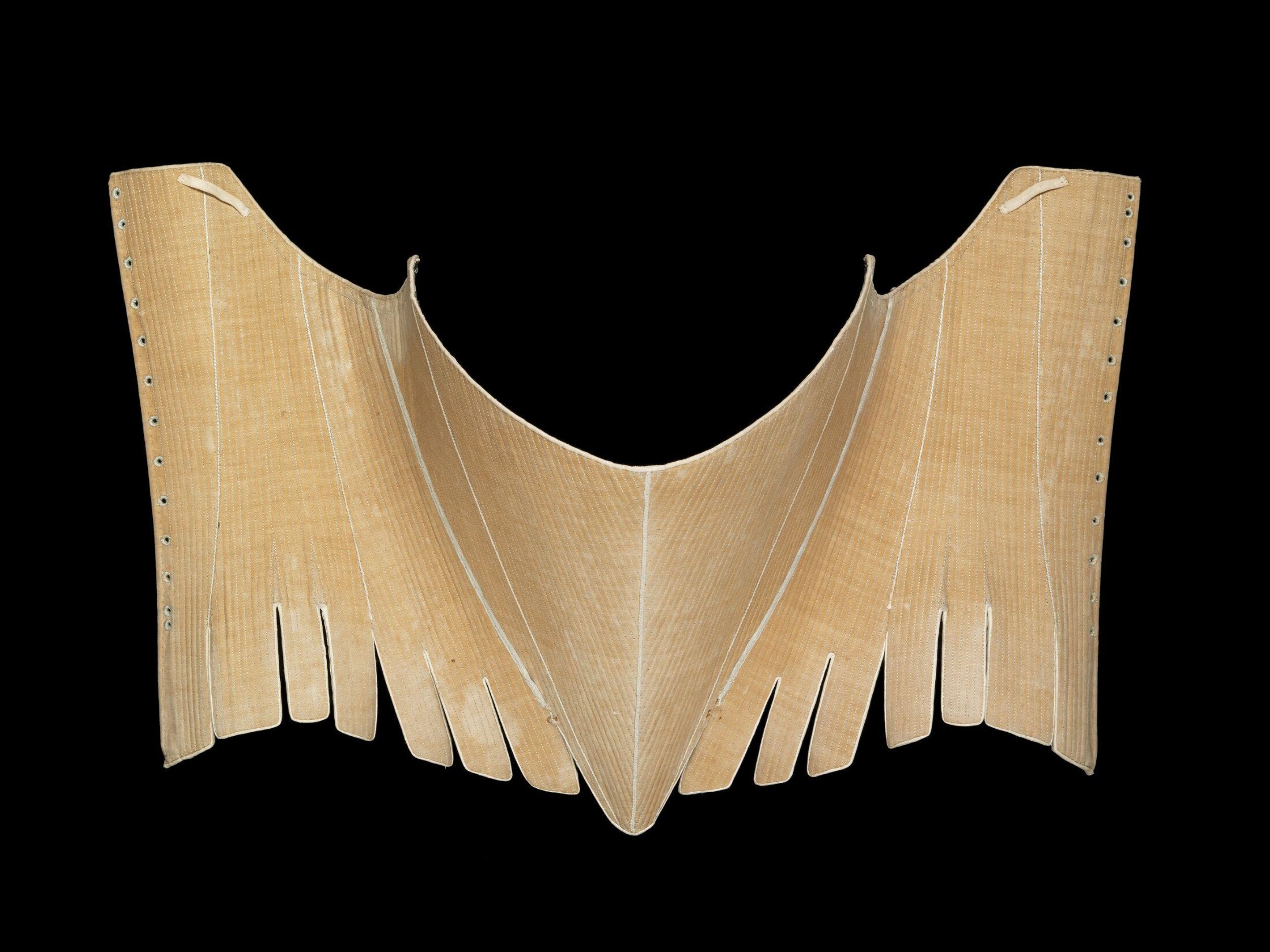
Stays 1780-1789 (made) Pair of stays, c.1780s. Formed from pink linen and trimmed with pale blue silk. V&A T56.1956
Based on the amount of available extant examples, rounded rectangles appear to have been the most common shape, and was used from the start of the century, up until at least the 1780s.
There is a 1790s pair featured in Stays or a Corset that also has rounded rectangular tabs, so that shape was in use at least until the end of the century. However it doesn’t appear to have been the most fashionable shape for stay tabs in the last quarter of the 18th century, as we are about to learn…
Triangular Tabs
Pointed Triangular Tabs
The earliest examples of stays with pointed triangular tabs date from 1770 onwards, and are all on stays that are very similar to the ones we used as inspiration for the Augusta Stays.
Like this pretty greeny-gold pair and its very pointy tabs:

Corset (Stays) 1770-1780, silk, baleen, silk stitching, Scotland, CT38-1984, National Gallery of Victoria, Melbourne
And this shapely mushroom pair with its narrow, narrow boning:
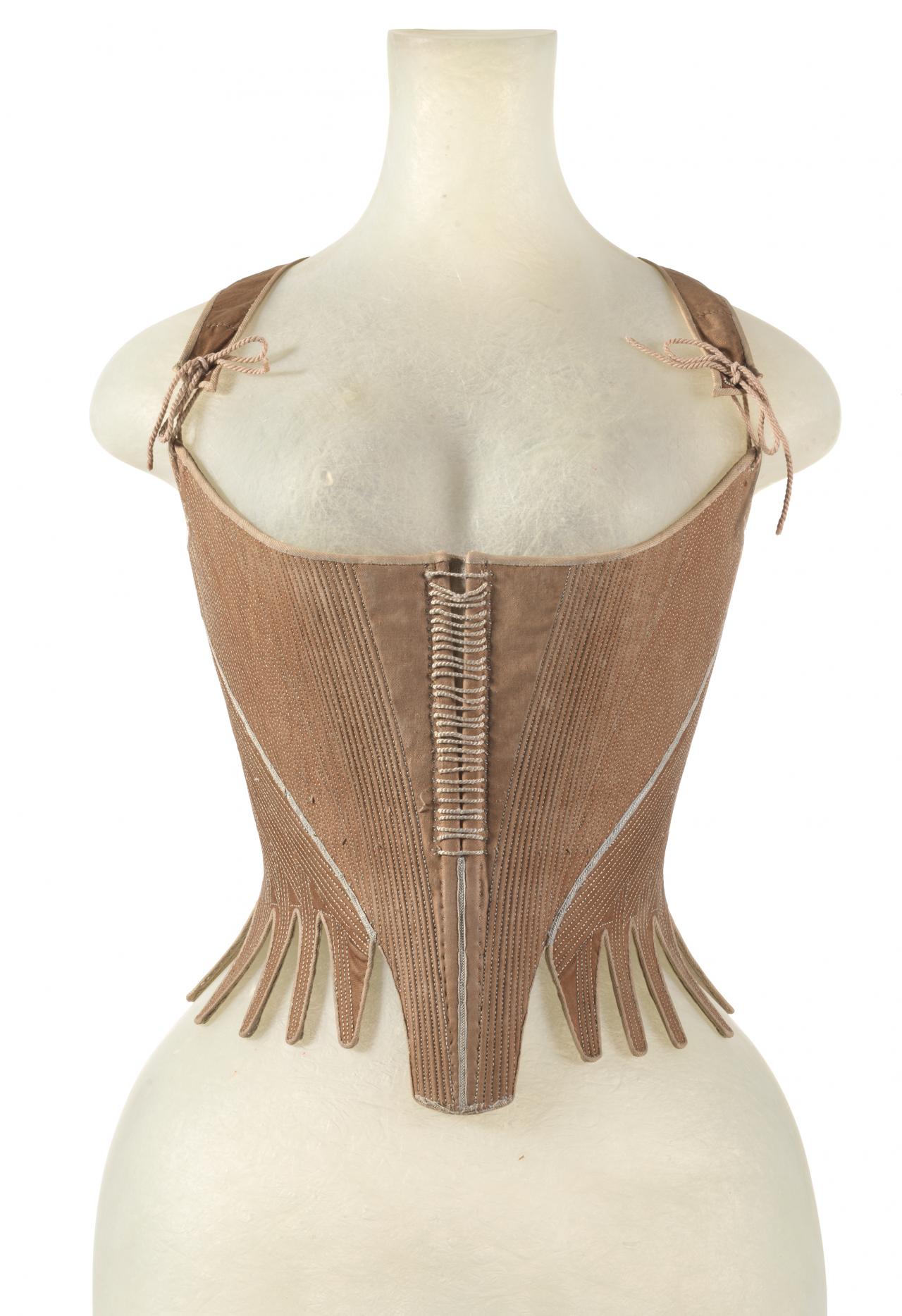
Corset (Stays), c. 1770-1780, SCOTLAND, cotton, linen, silk, baleen, Scotland, National Gallery Victoria (Australia) CT161-1983
Brown appears to have been a very fashionable colour for stays in the 1780s:

Half-boned stays, 1770s-80s, French, Musee du Costume et de la Dentelle
Look at all those triangular tabs!:

Stays, 1780s, Abiti Antichi
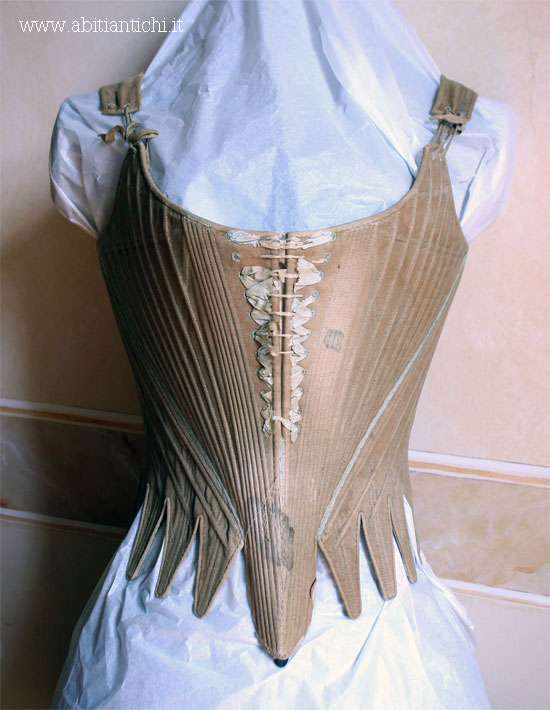
Stays, Abiti Antichi, ca. 1780
This lovely purple damask pair has front lacing only, and triangular tabs:
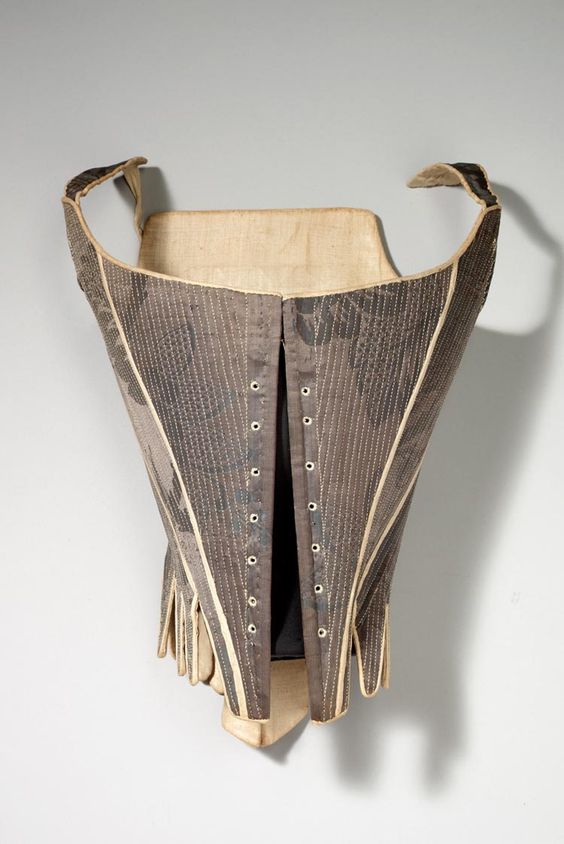
Stays, 18th century (probably 1780s), B000117, Stichting Rijksmuseum het Zuiderzeemuseum, Enkhuizen
Pointy, pointy, pointy:
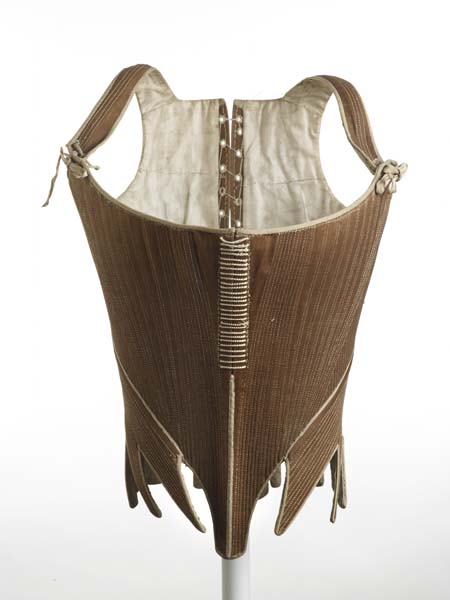
Corset (stays) brown cotton twill, 1780-1795, Museum of London, 49.91:1
Stays with a very cool front point, and then loooooong pointy tabs:
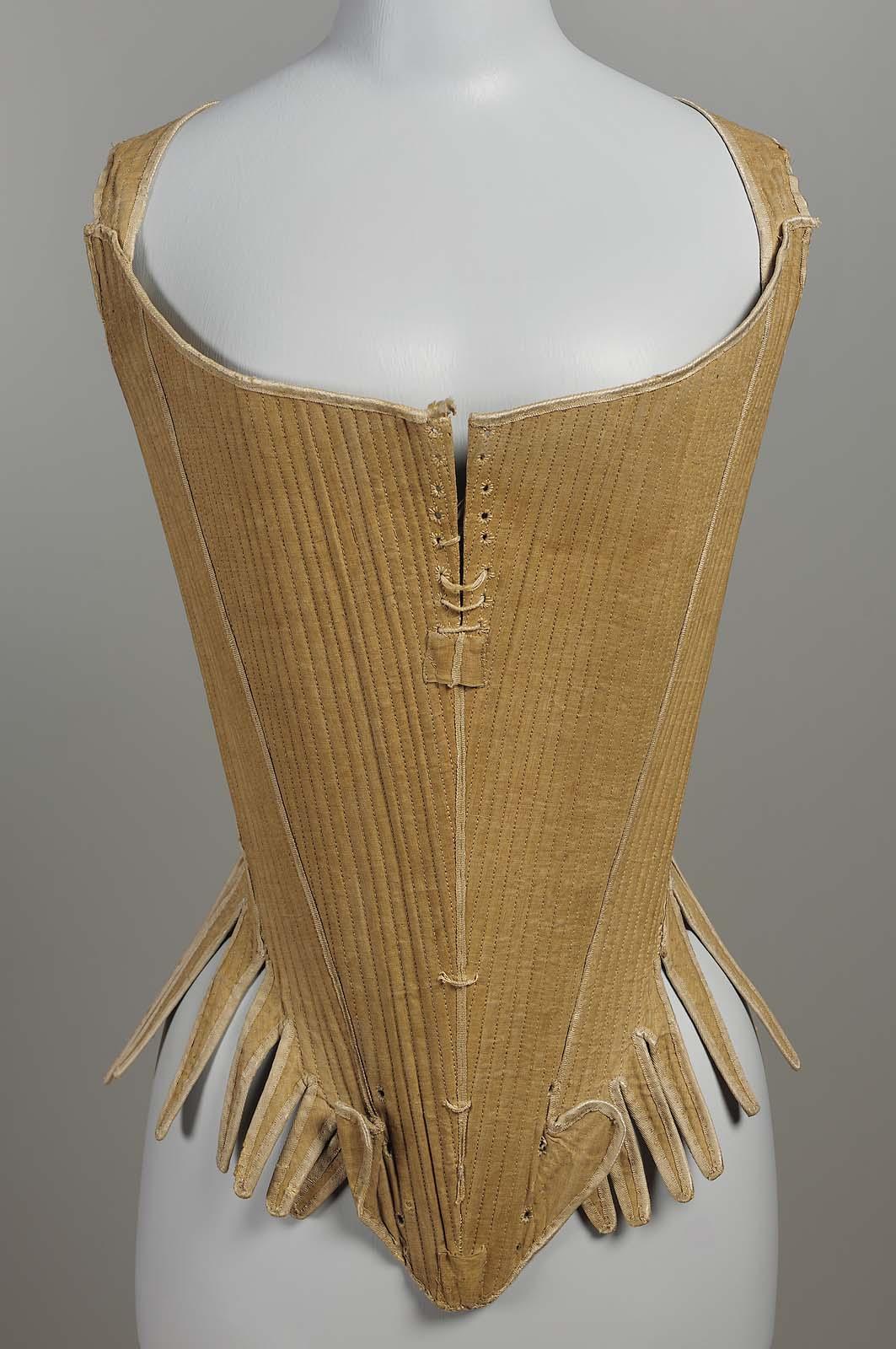
Stays, Western European, 1770–90, Linen plain weave, baleen and silk tape MFA Boston 43.543
So, very triangular tabs seem to have been exclusively used from 1770 onwards, and primarily on very fashionable stays.
What about truncated triangles?
Truncated Triangular Tabs
The line between rounded rectangles and truncated triangles is somewhat blurred, but I feel this pair has a definite tapering to its tabs:
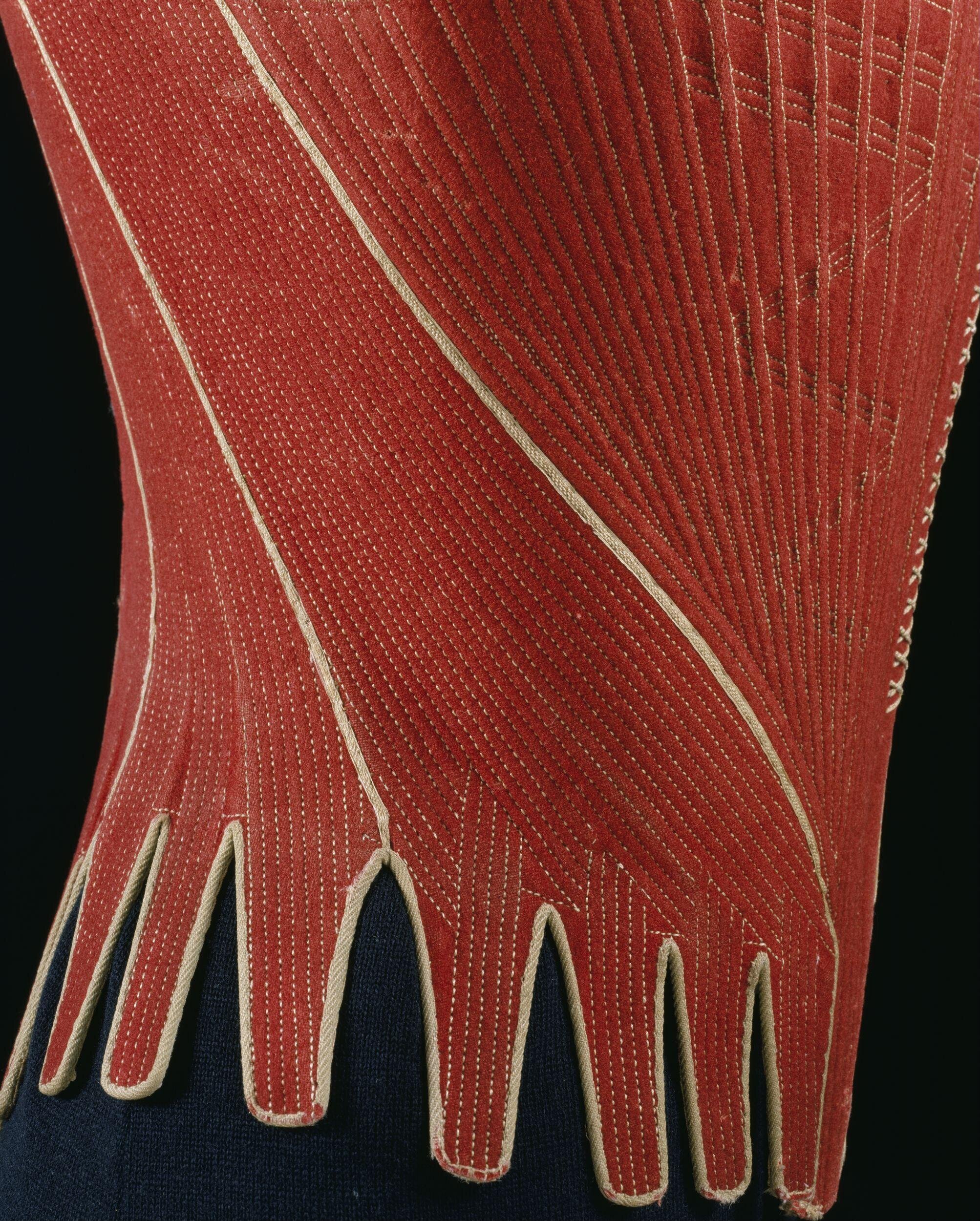
Woman’s stays, 1780s, British; Red wool trimmed with cream silk, boned, back lacing, laced shoulder straps T192.1929
As does this pair:
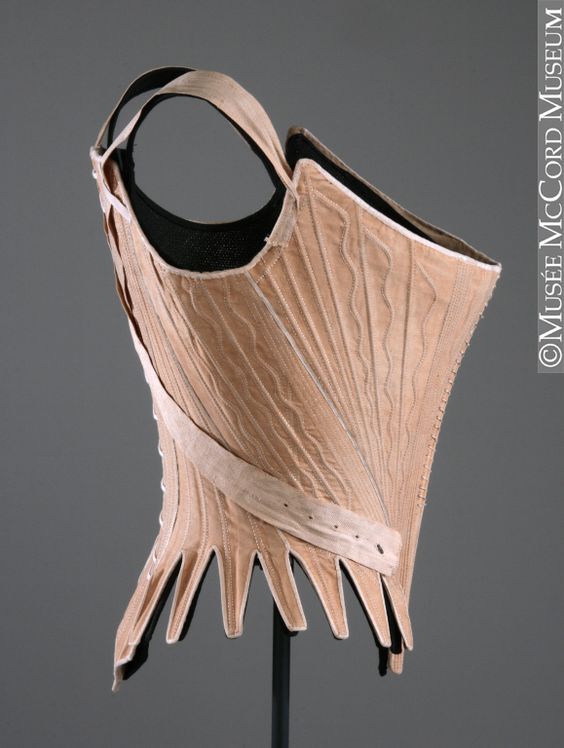
Stays, 1785-90, Musee McCord M969X.26
On this pair, in a colour very similar to the NGV ones with pointed tabs, the truncated triangular shape is very clear:
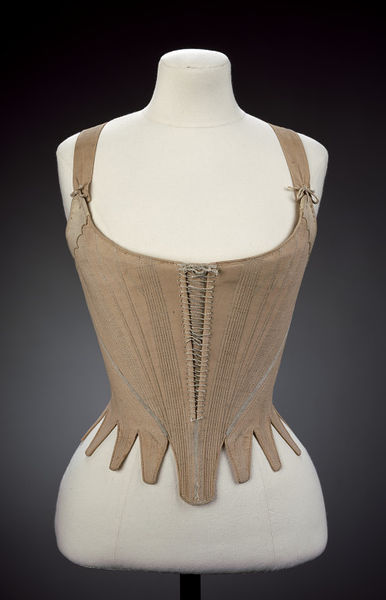
Stays, Great Britain, 1780-1789, Linen, hand sewn with linen thread, applied ribbon, chamois and whalebone, VAM T.172-1914
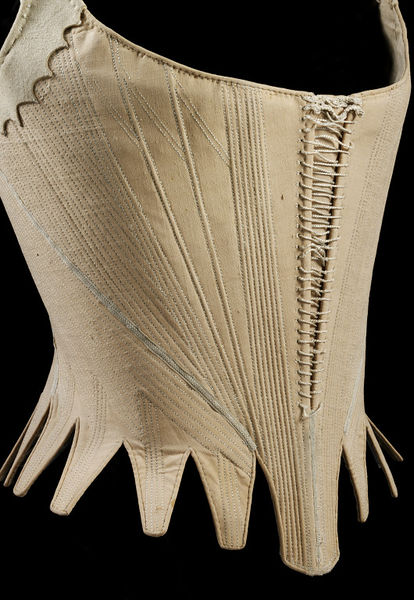
Stays, Great Britain, 1780-1789 (made), Linen, hand sewn with linen thread, applied ribbon, chamois and whalebone, Victoria & Albert Museum, T.172-1914
Look at the lovely tab shape on this delightful yellow pair:
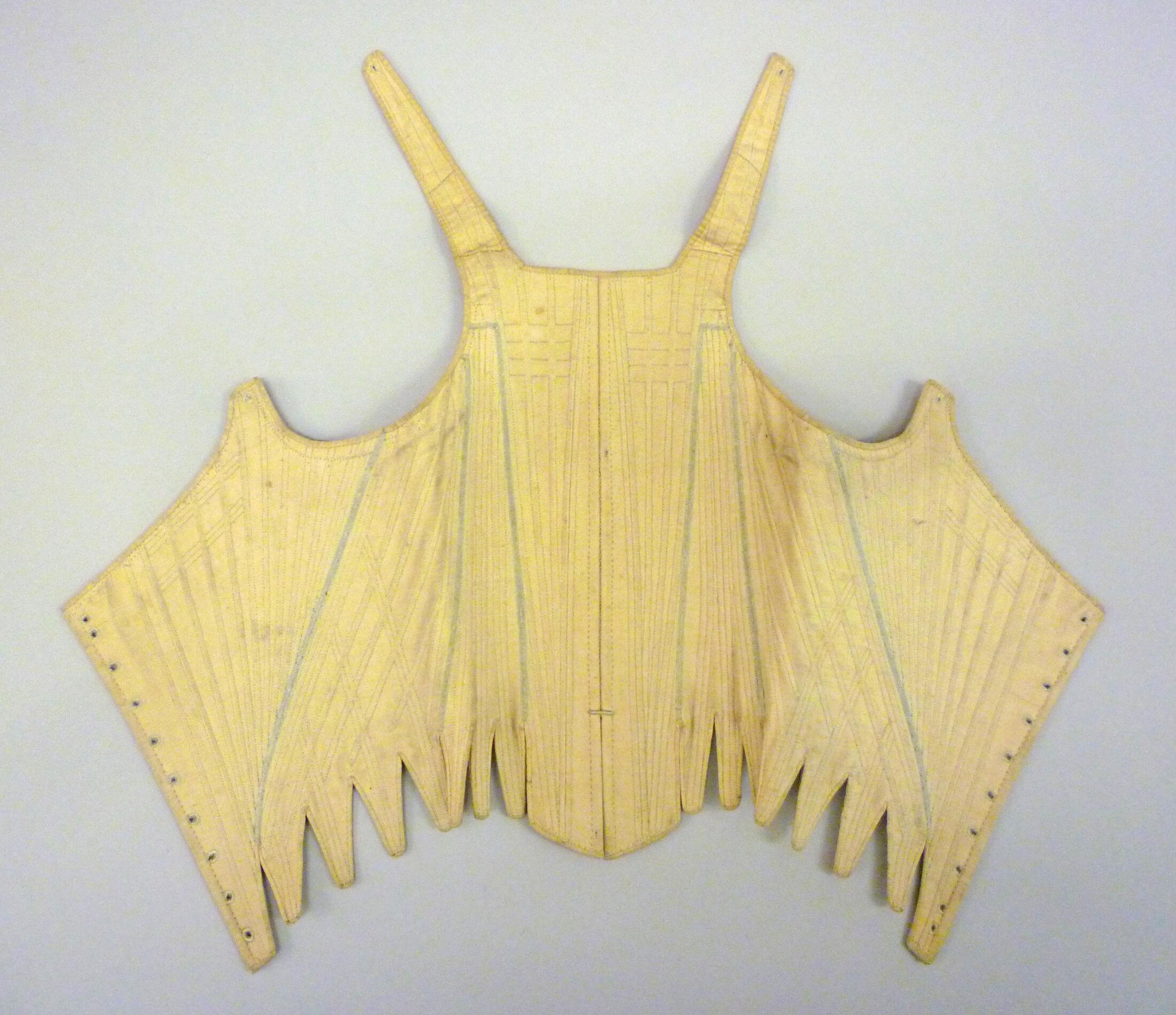
Woman’s stays of linen trimmed with pale blue silk, 1790-95, British; partially boned, front lacing, Victoria & Albert Museum, T32.1914
And that shape continues into the very short transitional stays/corsets of the 1790s:

Stays, England or France, ca. 1790, Cotton with silk embroidery, boning, and lined with linen, © Victoria & Albert Museum, T.237-1983

Corset (Stays) very late 18th century, American or European, cotton, silk, Metropolitan Museum of Art, C.I.41.94
So, based on these examples, fully triangular tabs exclusively appear on stays from the 1780s onwards.
Tab Shape Unclear:
We’re starting this section with a pair of stays that is a bit of an anomaly. It has a very unusual front treatment, and the underarm protection appears to be a later addition. The first two tabs are distinctly triangular, but the rest appear to be rectangles, so its not a perfect fit for any category.

Stays, early 18th century, Spanish silk, Metropolitan Museum of Art, C.I.46.59.3
I’ve also placed this lovely pair of pink stays in this category too. Certainly the side front points are truncated triangles, but what you can see of the remaining points suggests the rest are rounded rectangles. I’d love to see more photos, but only one shows up in the catalogue record (link through image) The presence of a bust rail and the shape of the pattern pieces suggests that this pair is from the later end of its date range.
The same lack of clarity about tab shapes applies to this pair:
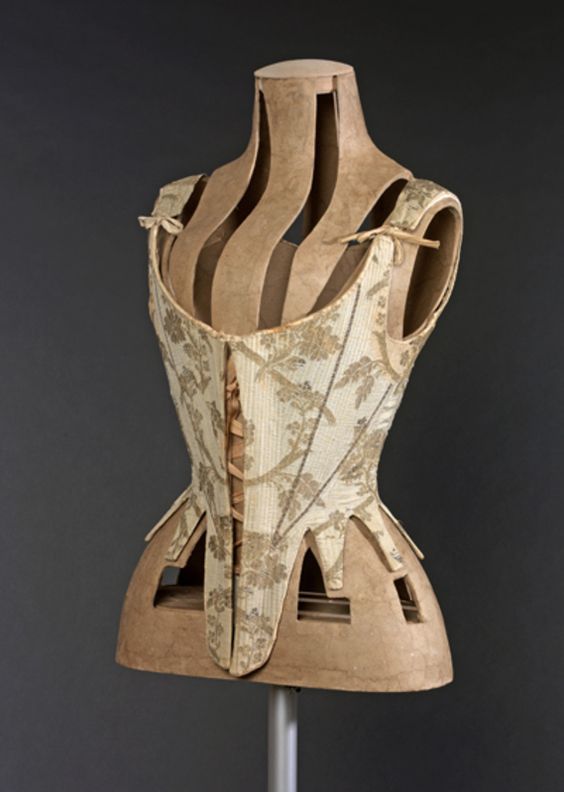
Stays, Probably 1770s, Museu del Disseny de Barcelona
Another pair where you can’t quite see what’s going on, although it appears to be rounded rectangles:
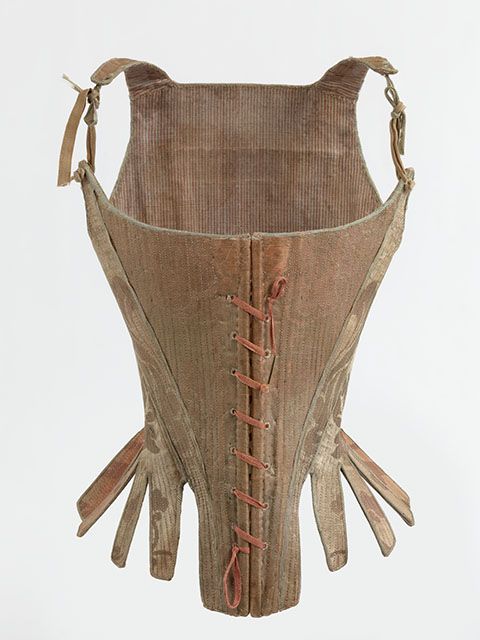
Stays, 1770-90, silk damask trimmed with linen tape, linen lining, the lacing cord is 18th century but is not original to this pair of stays, Fashion Museum Antwerp via Europeana Fashion, T12/123/O11
Conclusions:
Tab shapes to appear to correspond to dating.
Extant examples suggest that triangular tabs, whether pointed or truncated, are primarily seen in the last quarter of the 18th century.
Rectangular tabs appear throughout the 18th century, but may have been less fashionable or cutting edge in the last quarter.
Slightly rounded rectangular shapes seem to have been the most common shape in stay tabs.
That’s my current working theory for stay dating and drafting based on available evidence, but, like all research, it’s subject to change!
Do you know of any examples of stays that I didn’t include that support or contradict this conclusions? Leave a comment and let me know!
And, go forth and use this information to make your own stays more accurate to the look you want to represent!

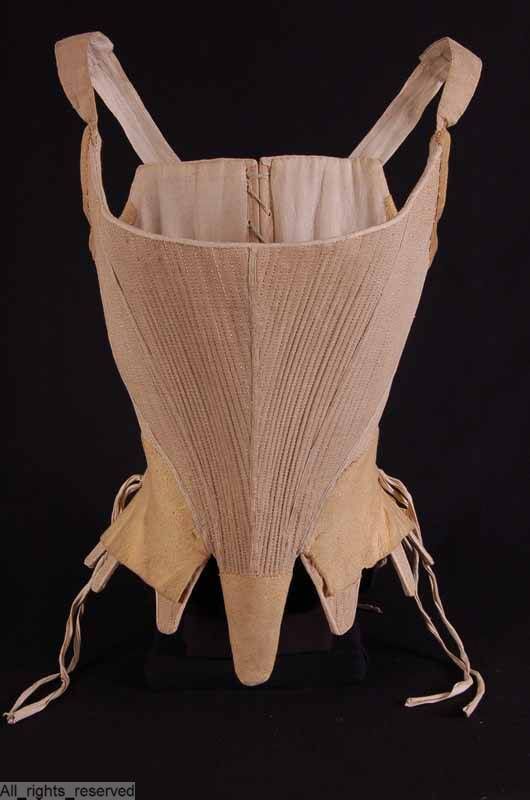
I love how the digitalisation of museum collections allows for this kind of research!
Here’s another pair from Czechia. Sadly no specific dating (my rough guess is earlier in the century, though), but it seems to further support your theory about our local styles AND has another interesting front point treatment:
https://sbirky.moravska-galerie.cz/dilo/CZE:MG.U_18949
On closer inspection… back hip gusset, so it’s probably about the Cassandra time range, actually. My initial gut instinct was a tad earlier, as it’s rather reminiscent of some depictions from 1740s in Moravia, but that hip gusset is definitely more modern than that. This goes to show this topic still isn’t where I’m naturally at. 😀
Interestingly, the rectangular style of tabs seems to carry over even into most later folk costume bodices in Czechia, if they have tabs at all. The one exception is the codified form of folk costume of Blata (region of Southern Bohemia), where the bodice is rather reminiscent of a pair of Regency stays Bernhardt-style, with round tabs. So it’s a bit of an interesting outlier on two levels (bust gussets + round tabs). But of course that’s not 18th century.
What is 18th century is this garment:
https://cz.pinterest.com/pin/224898575119726735/
– an example of rectangular tabs appearing even in folk costume bodices.